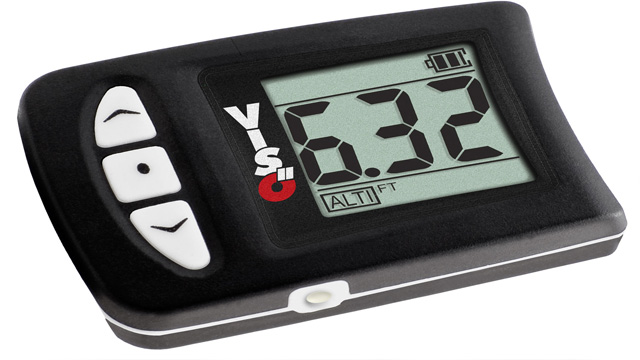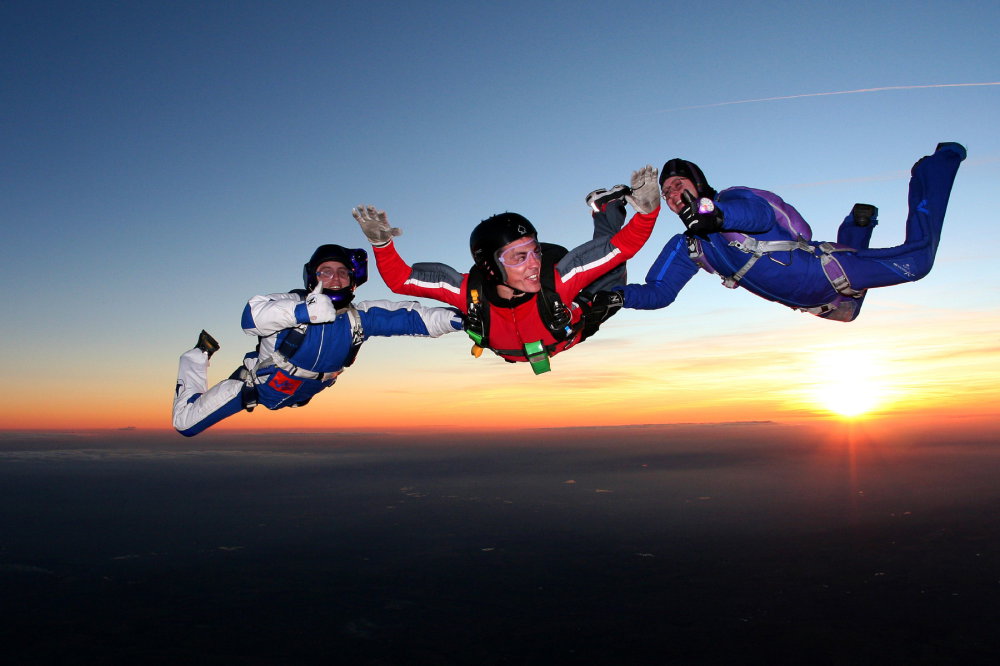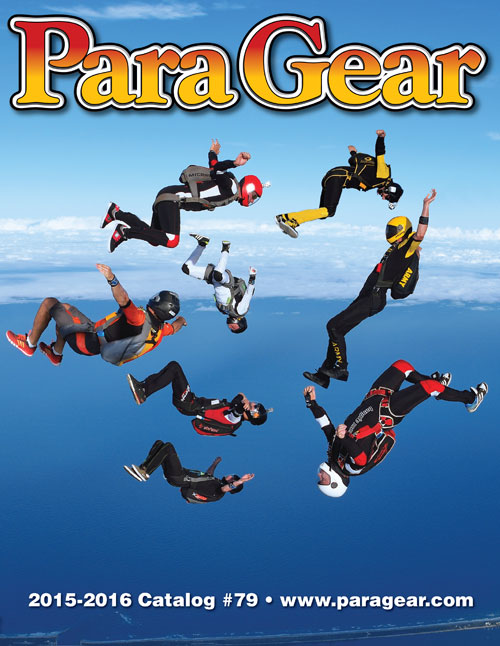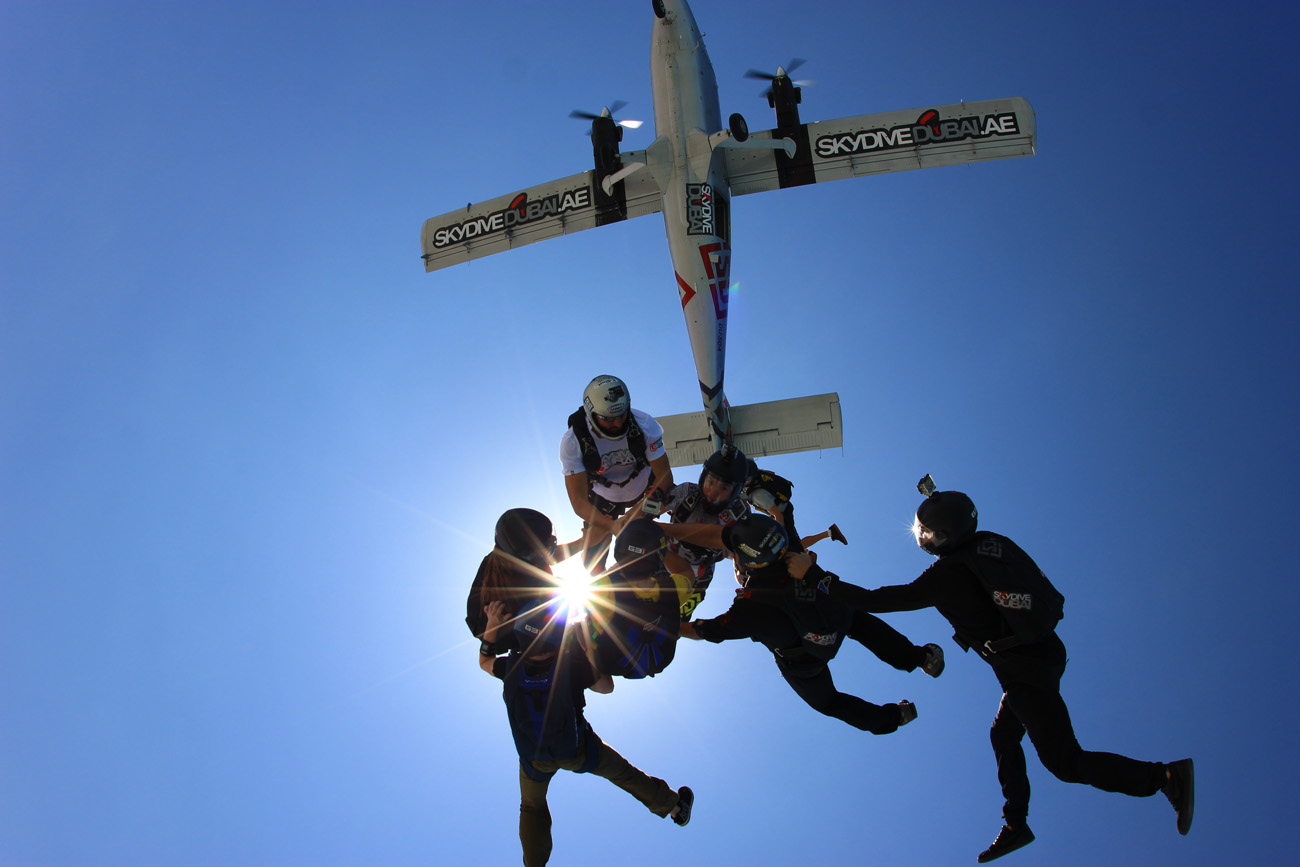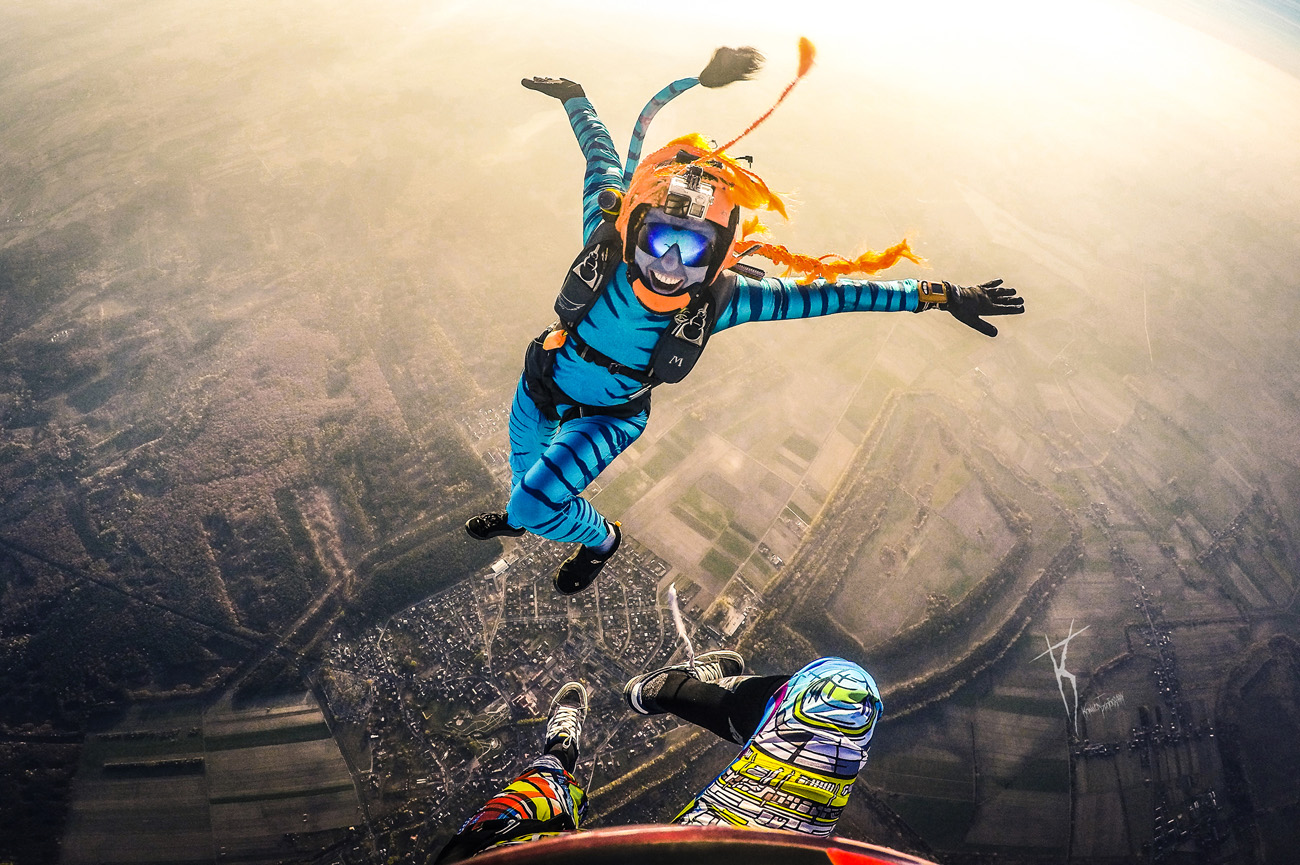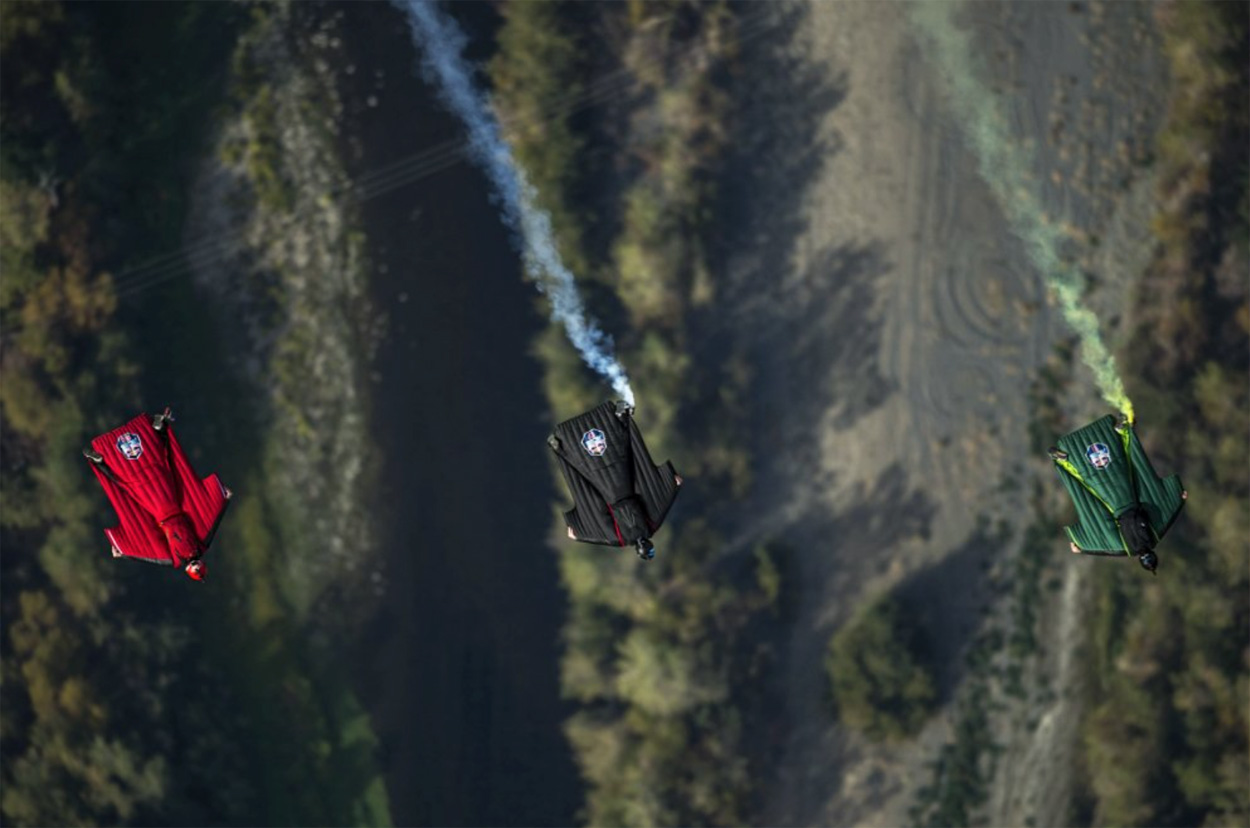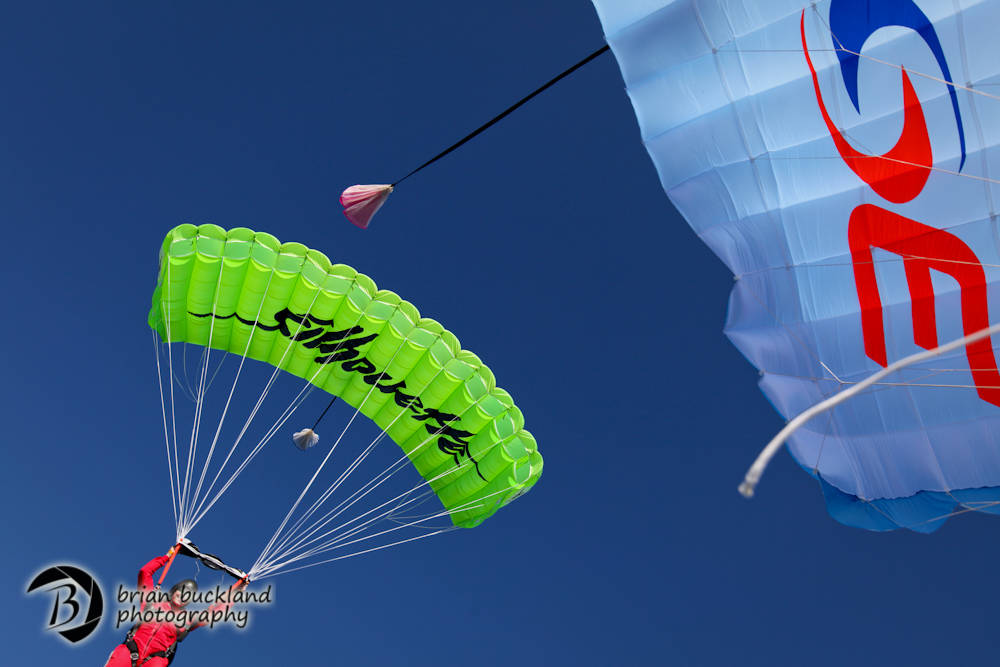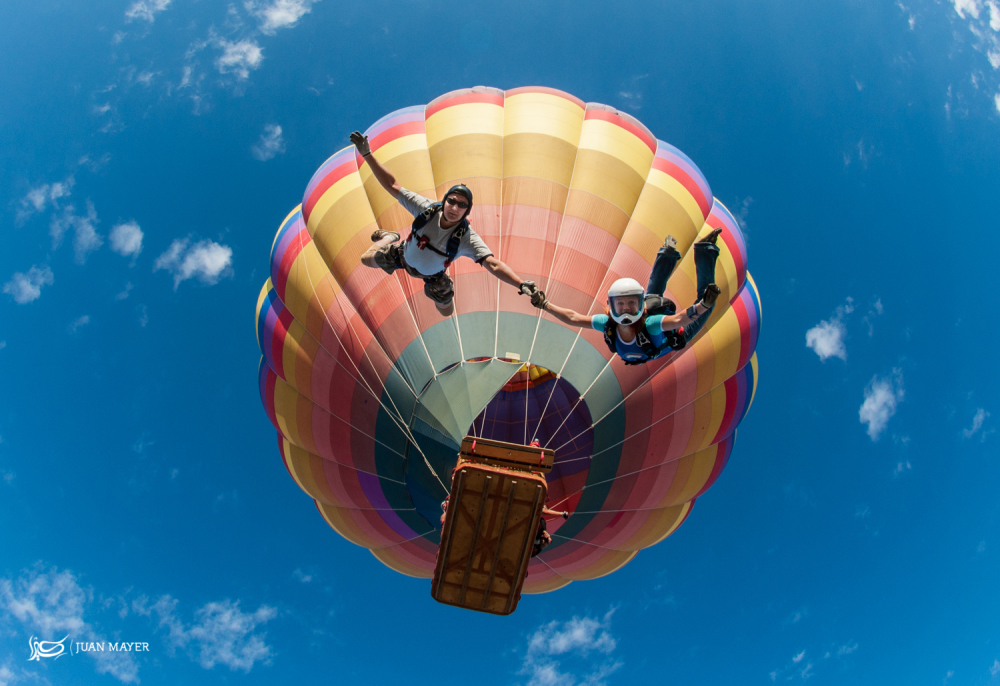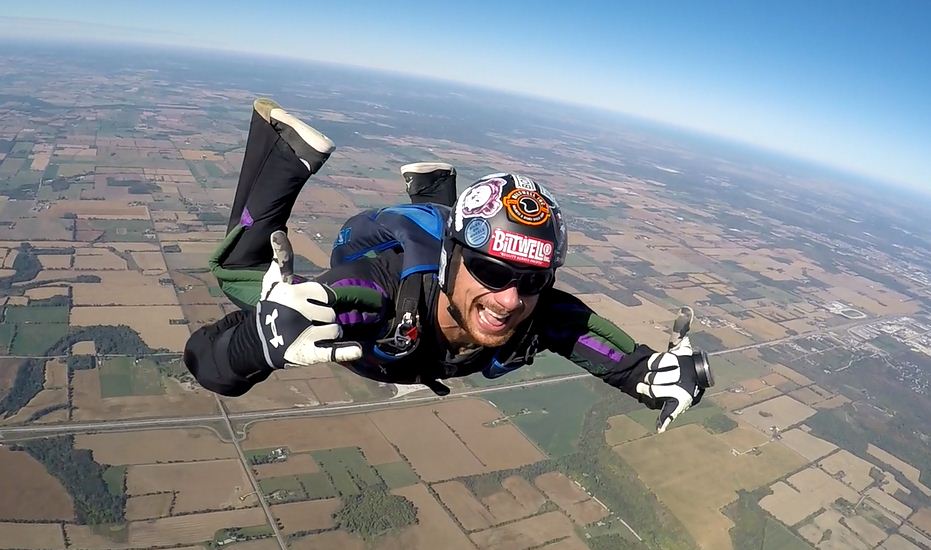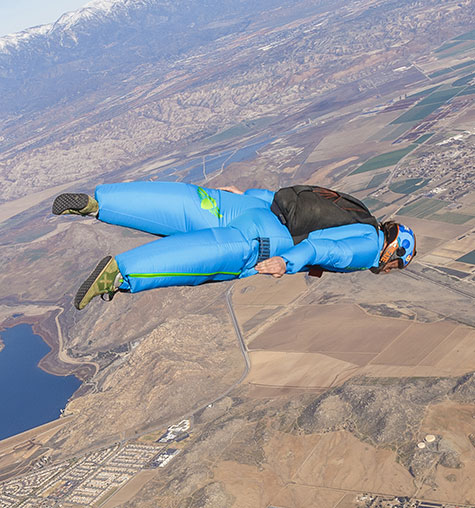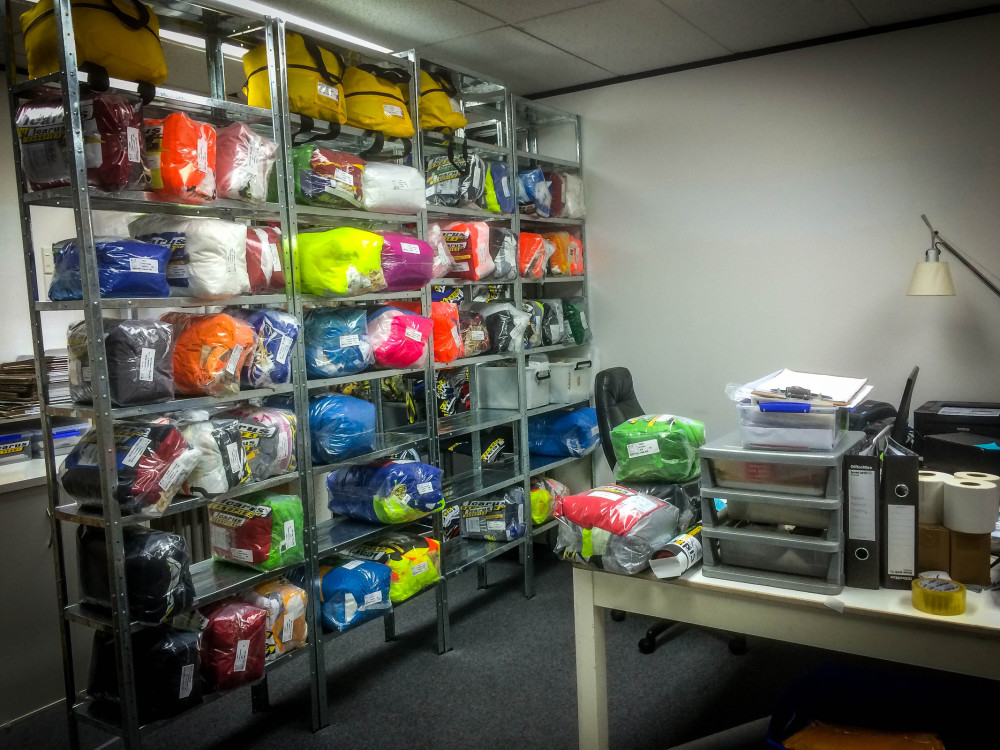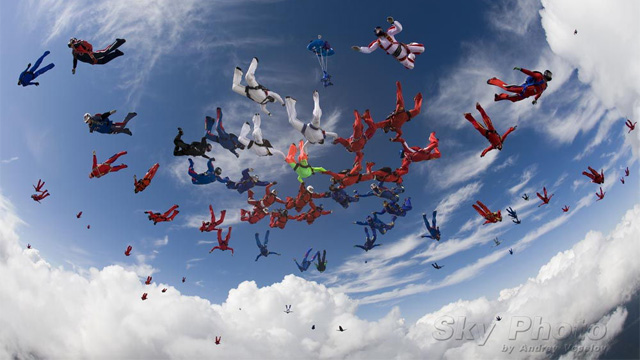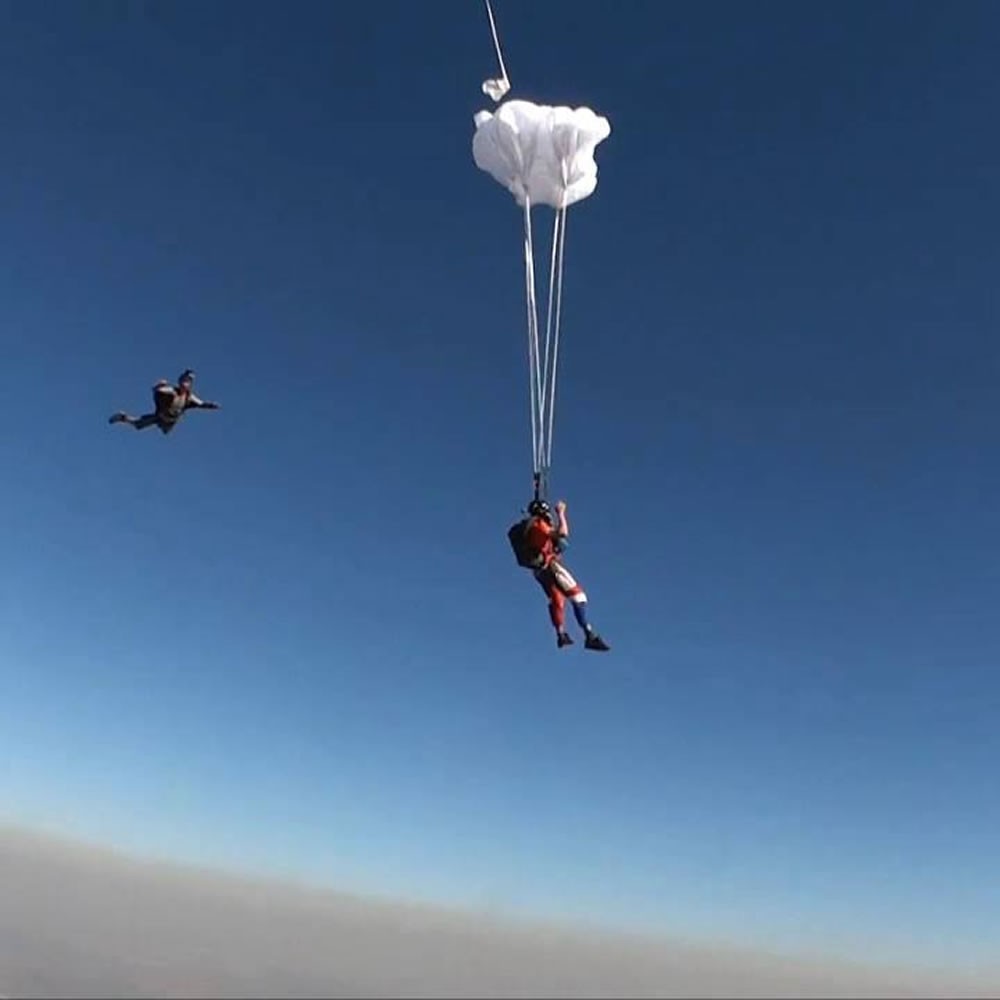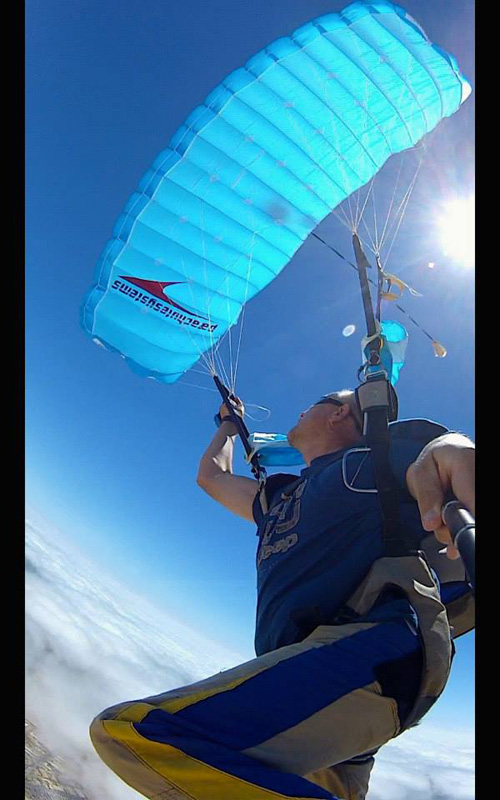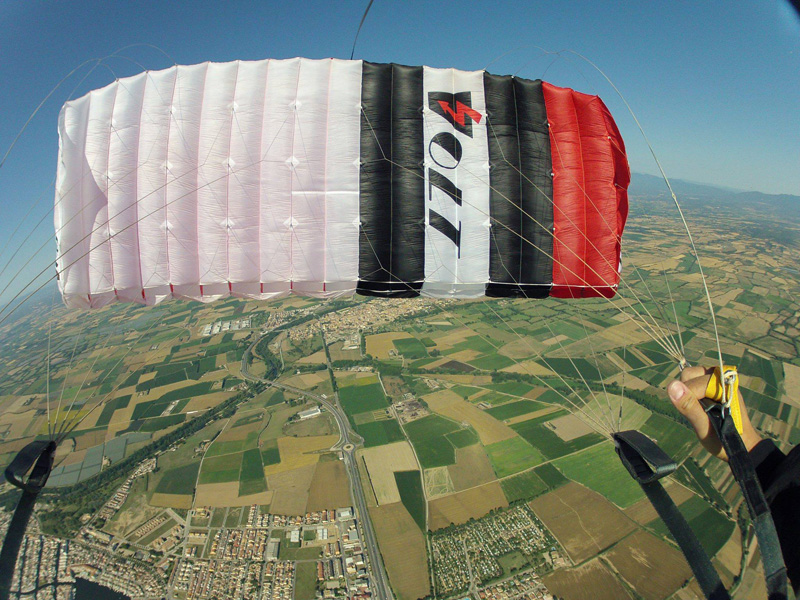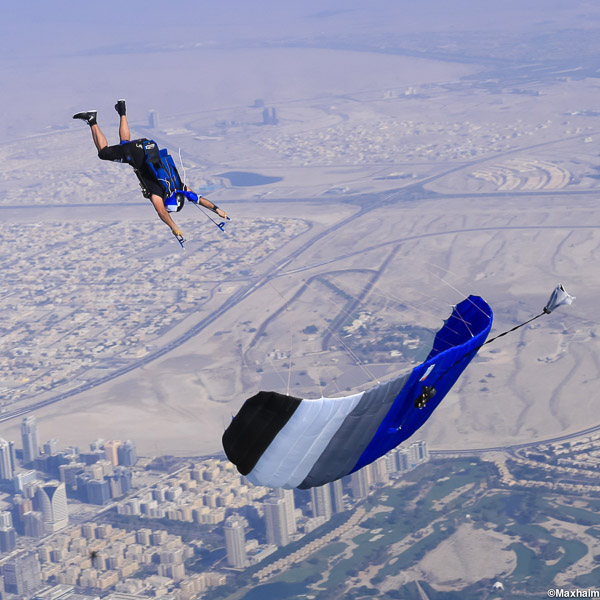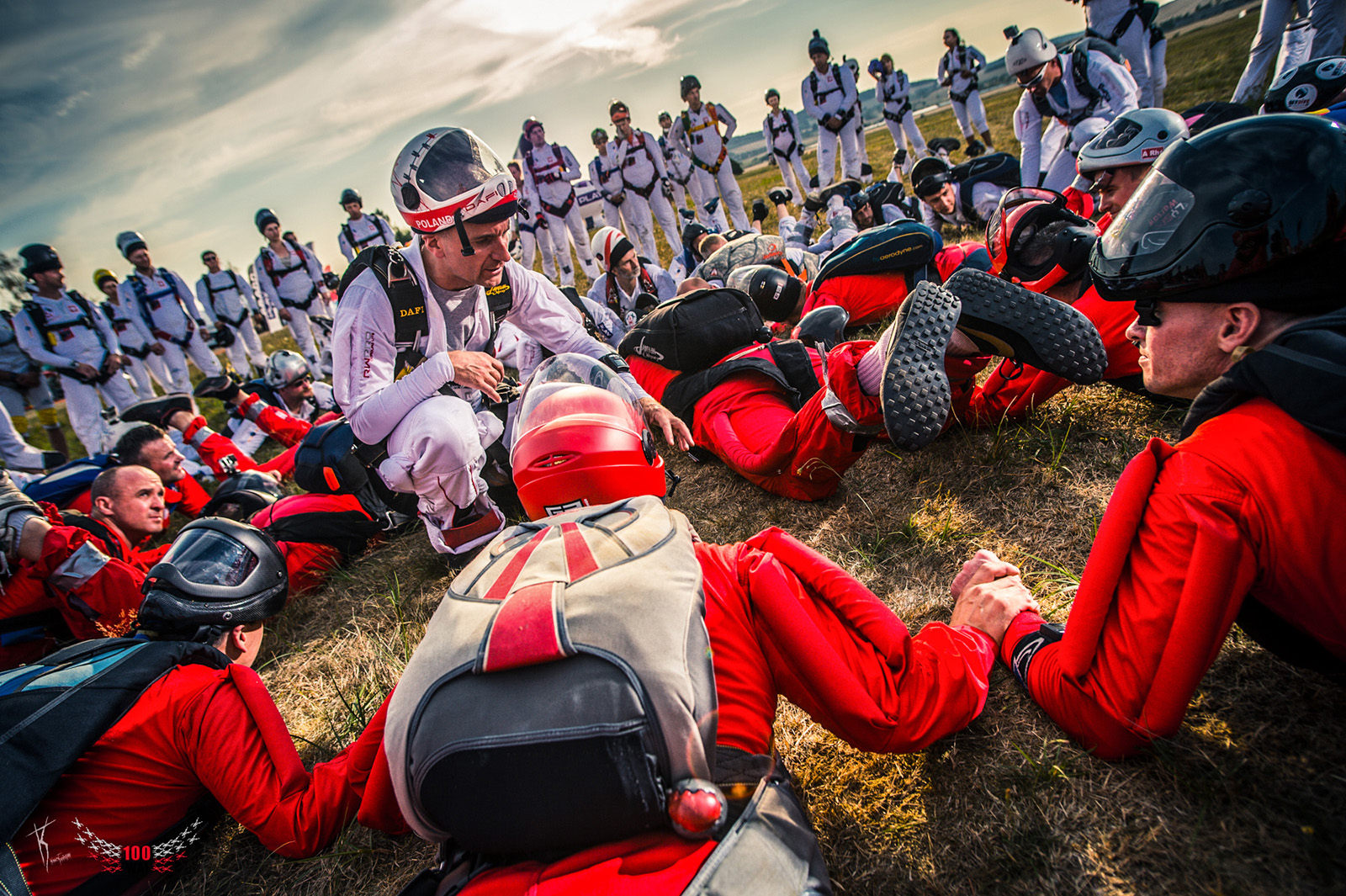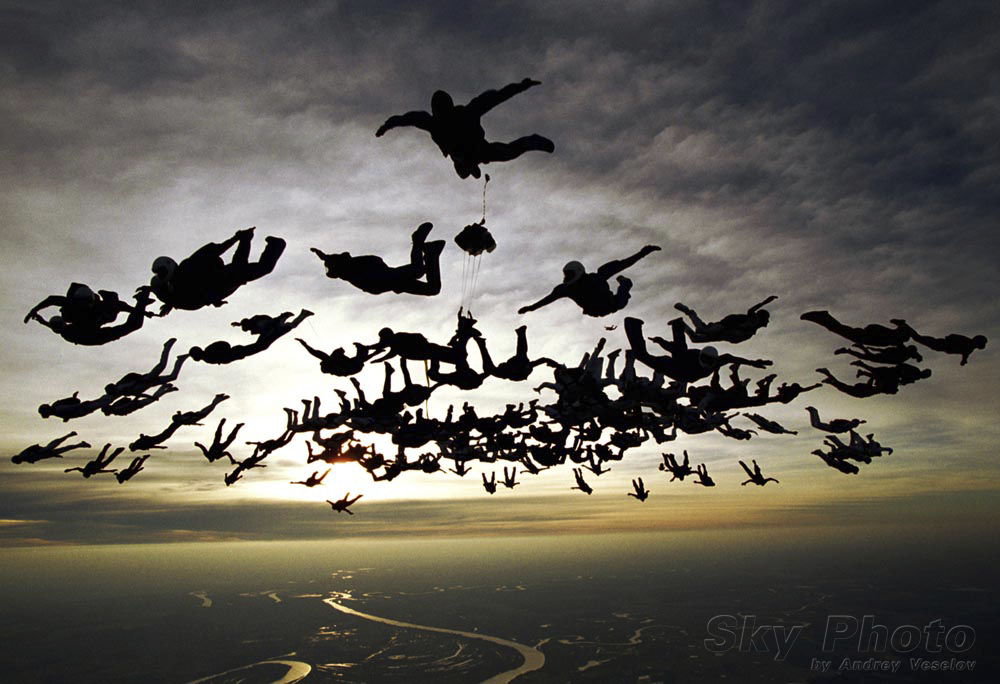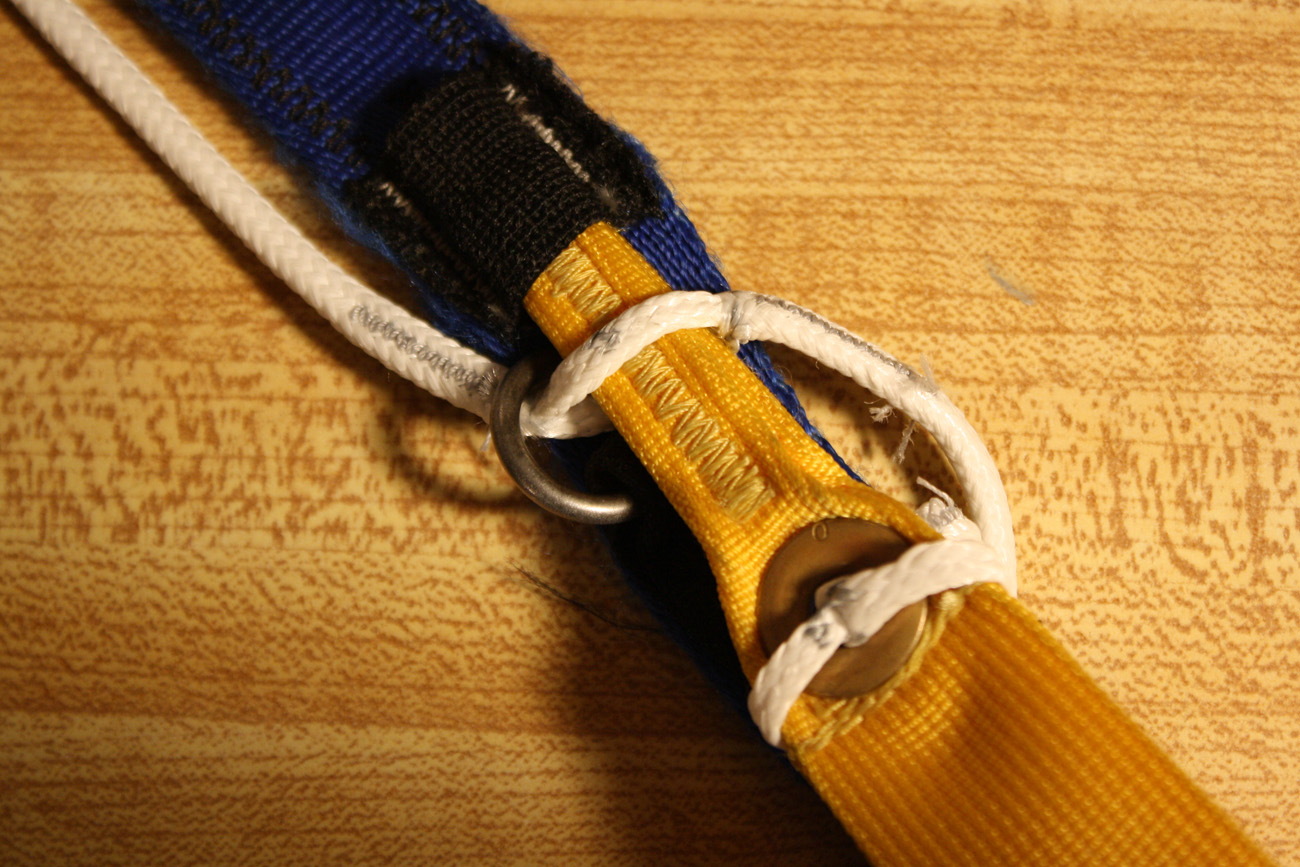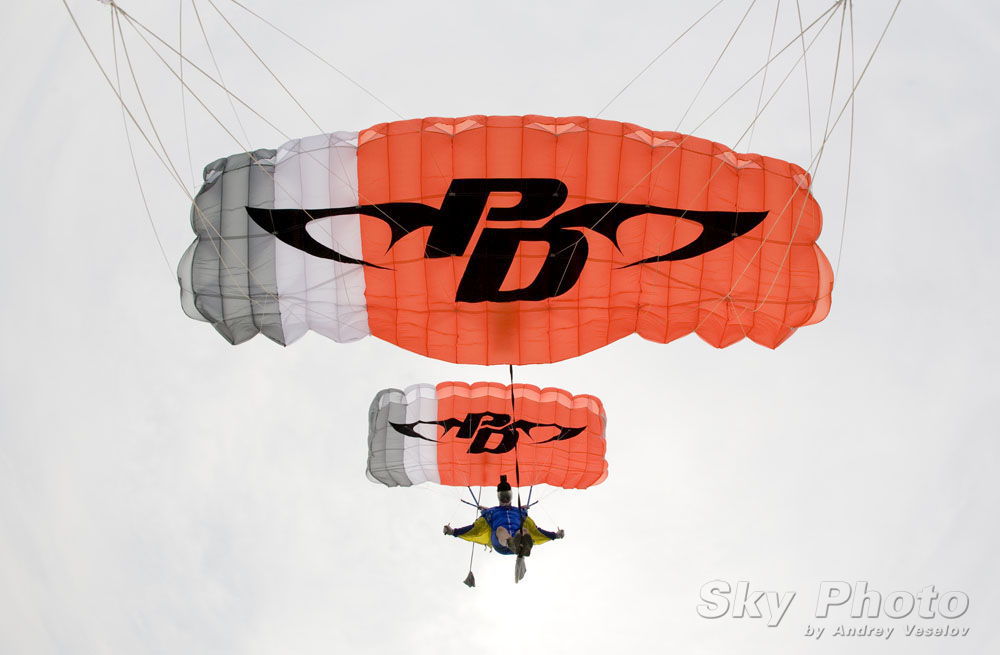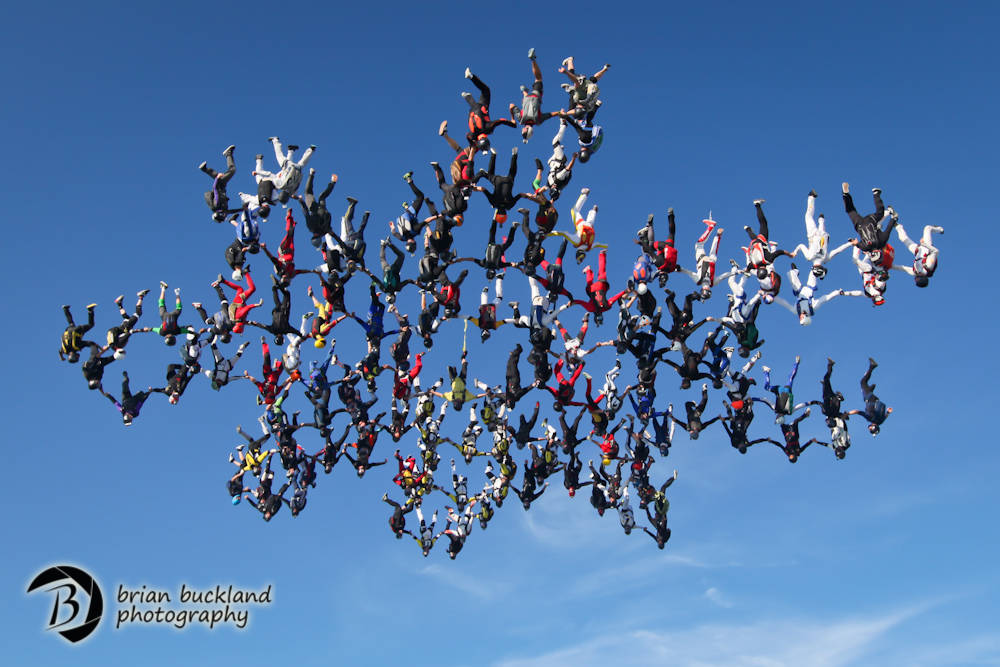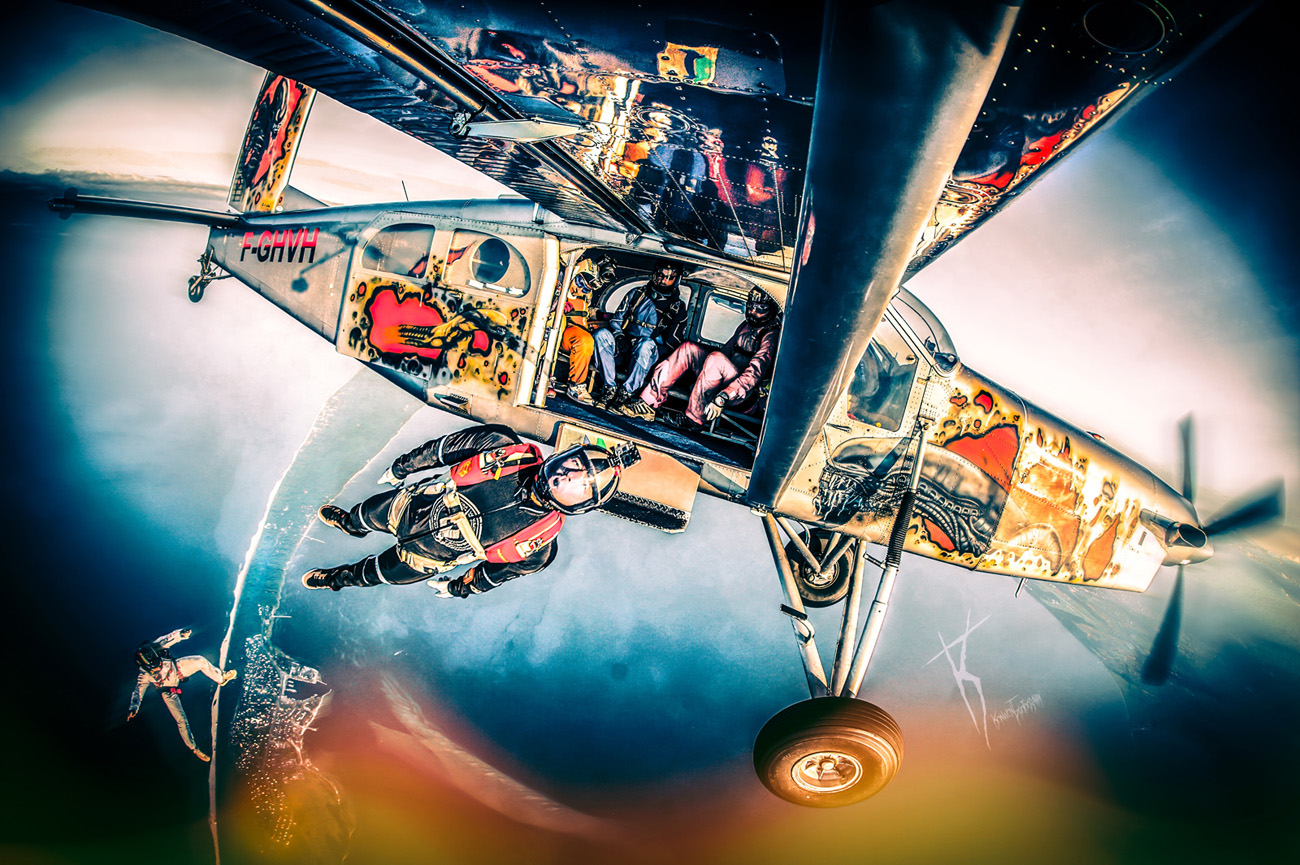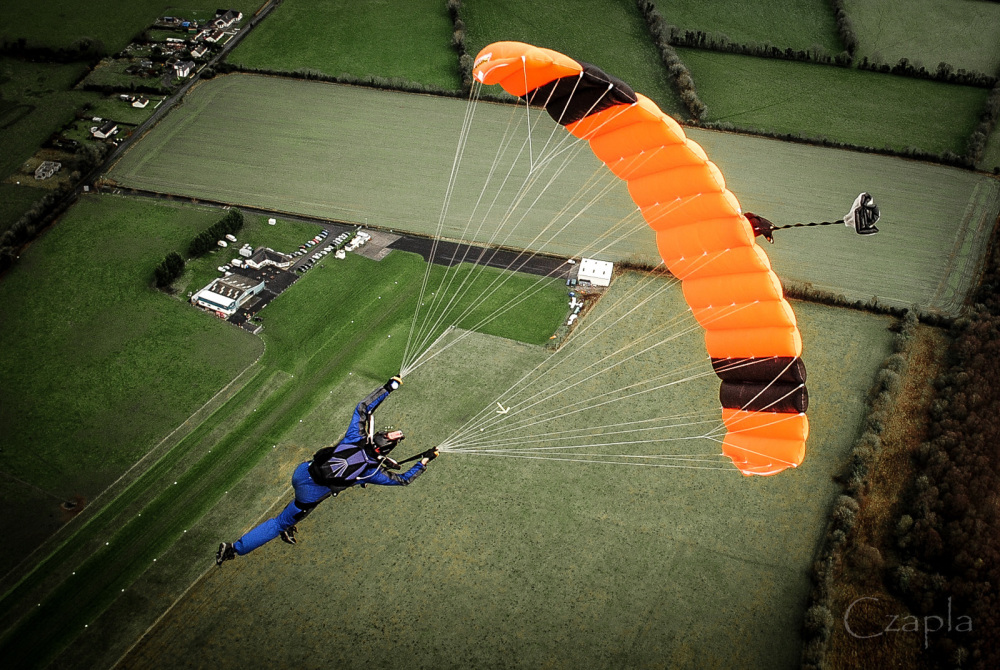-
Content
-14 -
Joined
-
Last visited
-
Days Won
1 -
Feedback
0%
Content Type
Profiles
Forums
Calendar
Dropzones
Gear
Articles
Fatalities
Stolen
Indoor
Help
Downloads
Gallery
Blogs
Store
Videos
Classifieds
Everything posted by admin
-
Got a Christmas bonus that needs spending? Have you left it a bit late in getting your Christmas shopping done? Still need to pick up something for one of your mates or partner? Well if they happen to skydive, we've got a few suggestions for you last minute shoppers in order to make sure the tree isn't left bare this month. Skydiving Christmas Cards & Gift Tags ($4-$14)Keep the skydiving spirit through the holidays with Skydiving Christmas Cards and Gift Tags! Available individually or in multi-card packages. More Information Peeksteep Spike Parachute Packing Tool ($20)The skydiver's packing tool is now available in 5 different colors! Brighten your skydiver's holiday with a Parachute Packing Tool in their favorite color. More Information Vented Tropos Arch Goggle ($45)The Vented Kroops Arch goggle features a patent pending soft elastomer frame that provides a comfortable, cool, and dry fit on any face size or shape. More Information ChutingStar eGift Card (Any Amount)The ultimate gift for the skydiver in your life that you just can't decide on what they want or need. The perfect last-minute gift too as the ChutingStar eGift Card is delivered immediately via e-mail! More Information Viso II+ Altimeter ($283)The VISO II+ is a digital faced visual altimeter for those skydivers who prefer a digital display over a traditional analog display. VISO II+ is packed with features and is the perfect visual solution for skydivers. More Information Cookie G3 Helmet ($380)Welcome to the G3 headgear, Cookies latest release full-face headgear and a result of significant refinement of the previous full-face headgear. More Information Other potential gift ideas can include: - Skydiving DVDs - Clothing - Rigging Equipment - Sunglasses
-
Over the course of the next few weeks we will be sharing the journal of John McDarby, who documented his experience as an AFF student. This journal should allow for new students to get an idea of what to experience during their first steps into the sport. Accelerated freefall (AFF) is a method of skydiving training. This method of skydiving training is called "accelerated" because the progression is the fastest way to experience solo freefall, normally from 10,000 to 15,000 feet "Above Ground Level" (AGL). “As far back as I can remember, I've always wanted to be a gangster. ...” Ray Liotta Goodfellas, I always loved that movie. I guess it’s kind of like living that gangster life for 2hrs which is so utterly foreign to anything most of us would know. Skydiving is something I’d always wanted to try, ever since a young age. I remember seeing a clip of people in a wind tunnel when I was about 12 or 13 and thinking “I’ve just got to have a go at that” But the usual trials and tribulations of day to day living, seemed to perpetually push it out. During my twenties, I actually went as far as getting the sponsor forms to do a charity tandem. But that’s as far as it got. It was placed on the back burner for another twenty years. One fateful day, a surprise email from my cousins wife arrived. “Can you come up with an idea for you and him to do something different for his 40th” was the request. Race car driving? White water rafting? Paintball? All the usual silly ideas we both bounced off each other. Then, the light bulb went “ping” We booked in for us both to do a tandem – he was as yet, unaware. The day came and the colour drained from his face when informed of the plan for the next few hours. That’s actually on video somewhere and is quite comical. For me, I’d had a month or two in order to come to terms with it. As it turned out, the rain came and the gig was off – honestly, I think we were both equally relieved and disappointed. We re-booked and again, it was rained off. I decided at that point, if it was rained off a third time, then that was it for me. It was a proper sign that skydiving was not something I was destined to take part in. But not this time. This time Thunderbirds were go. The day came and we hit the DZ. We signed our lives away, we jumped and we loved it. It was a surreal experience and one that I will never forget. No matter how many jumps I ever make through the rest of my skydiving career, I will never forget that first time sitting on the edge, feet dangling. On video, my tandem master asks prior to the jump: “Will you do this again or is this a one off, tick the box?” To which I reply categorically “one time, one time only” Yes, let’s see how that worked out... I must apologise for the soundtrack. Prior to the jump, whilst at the DZ, we had to select 3 songs from a list of thousands that were to be added to our video afterwards. I was much too preoccupied to choose them so the task was given to my niece of 12 years. “This will be hilarious” was the giggling consensus. And I was informed in no uncertain terms, that I was not to see the track listing until the final product. Which was later aired on the big screen in the hanger to much laughter. I’m a living joke... But...the deal made with my niece was that if she decided to choose the songs, then she would have to do a tandem when she turns 18. Aoife, the clock is ticking! So that was it. I walked away from a wonderful tandem experience and was determined that if nothing else, I had to complete “at least” one more jump. I couldn’t go through life and not try it again Knowing me and how I think, it made sense to sign up for AFF rather than another tandem. “I’ll do the ground school and one jump, then reassess” I told myself. Multiple emails back and forward to the IPC Irish Parachute Club, had me booked into school for the second Saturday in April – about 7 weeks after the tandem. I was hyper and couldn’t wait for the day to come. As it approached, the bravado began to wear off and nobody was happier than me that we did not get to jump that day due to weather. We would have to wait for the following Saturday. This was something that stuck with me until AFF6. I would never have been upset not getting any of the first 4 AFF jumps on the day. It was a genuine fight with myself to gear up and just do it. But afterwards, it was always such a buzz. At times, I even thought “I wish I could just fast forward the jump bit and get to the après-jump buzz” and go home. Unfortunately, you have to load and exit to get that. Now, I’m really happy and excited during the hour or so prior to kicking off. But that took a few jumps to get there. During the next week, I read the SIM twice. I looked at everything there was to see on YouTube. I even had my first skydive dream! Figuring that jumping from a plane, this time unattached to someone who knew what they were doing, I thought it best to know as much as I could. I did the AFF1 dive flow, over and over again in my head during the drive to and from work. I ran over my emergency procedures again and again. In fact, I still have the laminated cards with the bullet points, sitting on the dash of the car so that I see them every single day. I practice my EPs daily – numerous times. Rinse and repeat….always repeat. I went through my notes from class – why was I the only person taking notes? I’d never paid as much attention in all my school and college years combined. I asked more questions in that classroom than everyone else put together. This stuff was important and I wanted to know it down here rather than not know it up there. And then the day came… Part 2 will be published shortly, keep an eye out on the dropzone.com homepage to follow John's journey through AFF
-
Over the years Para Gear has used photos from all of skydiving's disciplines. We do not have a preference as far as what type of skydiving photo it is, rather we look for something that either is eye-catching or pleasing to the eye. In light of the digital age, we are also able to use photos that in one way or another may be less than perfect and enhance them, removing blemishes, flipping images, altering colors, etc. The following are preferences. However what we prefer and what we get, or choose, are not always the same. If however we came down to a choice between two photos of equal quality, we would opt for the one that met more of our preferences. We typically prefer that the photo be brighter. In the past we have used sunset photos and even a night jump photo, although by and large most of the photos are daytime. We like the subject of the image to have contrast with the background. Subjects that are wearing brighter more colorful clothing usually stand out more. We prefer to have the people in the photo wearing equipment since that is what we sell. Headgear, goggles, jumpsuits, altimeters, audible altimeters, and gloves are all good. We also prefer to see skydivers wearing head and foot protection. We do not print any BASE jumping nor any Tandem photographs. No submissions of these will be accepted. We are not interested an any photos of individual or groups of skydivers standing on the ground Our basic criteria is as follows: Vertical Format. The front and back covers of the catalog are both in a vertical format. We can use a horizontal (landscape) shot, as opposed to a vertical (portrait), and then crop it as long as the image lies within a vertical cropping. Photo Quality. The front and back cover shots will be printed as 8 ½ x 11 in 300 dpi format. Any film that can hold its quality up to this size and print dpi is fine. Digital format is preferred. In the event of a final cover choice, we prefer to be sent the original digital image or slide for getting the best quality out of the image. Back Cover Photo. The back cover photo is no different from the front except in one respect. We need to have room on the left side of the image for the thumb index. In the past we have taken images and been able to horizontally flip them thereby creating this room. Originality. Anything that is original, eye-catching, or makes someone take more notice of the catalog covers is something we look for. It could be a photo from a unique camera position or angle, a scenic skydive, shots under canopy, landings, etc. We look for photos that have not been previously published and most likely would not accept them if they have, as we want a photo that no one else has seen yet. We also do not want any photos that are chosen as the front or back covers to be used for other non Para Gear advertising for a period of one year. Para Gear offers $500.00 each for both the front and back covers we choose. Our current deadline for catalog cover submissions is January 11th 2016. Sending sample pictures by e-mail to [email protected], If you are sending sample digital pictures please note that they do not need to be in a very large format. If we like the sample picture we will then ask you to send the higher quality original. Please feel free to contact me directly with any questions.
-
Skydive Dubai’s Winter Festival runs from December 27 to January 2 at the Desert Campus. Sporting a new format it promises to be even bigger and better than previous years. The winter months can be tough on skydivers, especially those based in cooler climates. As the season slows to a halt, the ominous signs of winter set in around the drop zone. The door on the climb to altitude is opened less frequently, and the shorty summer suits begin to gather dust in the wardrobe. Protective clothing in the guise of t-shirts, gloves, scarves and that second pair of socks, start making their way back into the gear bags. The die-hards still hit the DZ every weekend, but leisurely fun jumpers appear less and less as the temperature at altitude plummets further and further below zero. Those in the know have been preparing for this for months. Instead of straining their necks looking for a possible gap in the clouds, they will be heading for the airport this December. Fast becoming the unmissable boogie of the winter season, and after its unprecedented success last year at Skydive Dubai’s Desert Campus, the Dubai Winter Festival returns with a brand new format that includes a new Advanced Freefly Skills camp. Winterfest attracts skydivers from around the globe, and caters to everyone; from those with a shiny new A-licence to head-down carvers, XRW enthusiasts and wingsuit rodeo heroes. The boogie will run from December 27th to January 2nd, ringing in the New Year with a line-up that would make even the most seasoned pro’s fist pump their way through the exit door. So after increasing that wing loading over the festive season, isn’t it time to swap the grey skies for some sun and sand? You might still need that woolly hat if the air-conditioning gets a bit chilly indoors, but the temperature, ranging in the mid-20’s outside, means that shorty-suit doesn’t need to be retired for the season just yet. Skydive Dubai photo by Brad Merritt“I don’t care what level you’re at. As long as you have a licence you can come out and play with us. We’re going to have small groups … and maybe try to build that up and get some 8-ways, and maybe even some 30-ways.” , said Eliana Rodriguez, co-coach with Skydive Dubai Assar Dubai skydiving team. Load organisers are available for all skill levels and include some of the most well-known names in the skydiving world. For the free flyers, MKTM return to Winterfest this year to continue pushing the boundaries of what is possible in the sky and the tunnel. They are joined by Azure Freefly’s Brad Merrit, Flight-1 instructor Pablo Hernandez, and Skydive Dubai ninjas Jim Harris and Anas Bekkali to name but a few. MKTM’s fearless leader Mike Wittenburg remarked during last year’s boogie, “The desert has a nice drop zone vibe … and everyone is pretty much guaranteed to have a skill level that they can jump with organisers.” For belly flyers, Eliana Rodriguez, Elena Christova and Craig Girard of Assar Dubai are back to boogie. Laszlo Csizmadia, Jane Oakley, and Regan Tetlow are also amongst the formation skydiving organisers ready to hone and perfect skills of all levels. Videos available from the 2014 Winter Festival available here.The wingsuiters will be led by top athletes Julian Boulle, Micah Couch, and Darren Burke. In an interview last year, Burke commented on his Winter Festival experiences; “The people I’m jumping with, that’s what makes the boogie. I’m just thankful to be here. It’s a pretty cool place.” This year the Winter Festival will also host a new Advanced Freefly Skills Camp, a dedicated 5-day event within the boogie incorporating dynamic, sequential, and angle flying. The aim is to progress skills in smaller groups, eventually combining these teams into larger formations. The camp runs for the first 5 days of the Winter Festival, December 27-31, and costs 3000 AED. Included are 30 organised jumps, dedicated load organiser, in-depth briefs and debriefs, and registration for the entire boogie, so you can keep on jumping! The Advanced Skills camp is for those who can already demonstrate safe and consistent approaches in head-up and head-down orientations, and can fly angles competently on their back and belly. And what about the free stuff you ask? As always the daily raffle will have plenty of surprises, and cash prizes will be awarded for creative videographers entering the Winterfest film competitions. All Winterfest participants will avail of discounted jump tickets and receive the ‘coveted’ Dubai Winterfest t-shirt. Don’t forget the daily videos that is created from you jump videos. There is even free on-site accommodation for pre-registrants, so not a moment is missed. Bring your own camping gear and immerse yourself in the festival vibe, or reserve a bed in the Bedouin tent and chill out under the moon and stars. Get in quick and secure your spot! The onsite hotel right next to operations building offers that bit more luxury. They can be contacted directly at [email protected] or by calling +971 50 8842 883. The Sleep Inn Hotel located in Silicon Oasis also provides easy access to the DZ and downtown Dubai, and don’t forget to mention Skydive Dubai to claim your discount. Registration costs 300 AED for the entire week, 100 AED for the weekend only (January 1-2), and is included in the fee for the Advanced Freefly Camp. All fees are payable on arrival. What are you waiting for? Pack that licence and a pair of flip-flops, and come to the sun for the Dubai Winter Festival! Register for the Dubai Winter Festival by filling in the online registration form, follow the Dubai Winter Festival Facebook event page for updates, and tag one and all on Instagram, Twitter, and Facebook at #skydivedubai. So in the words of 70’s disco idols Baccara, “Yes Sir, I can Boogie!” Skydive Dubai article written by our staff writer Seán Hahessy.
-
Halloween is the one day each year when you can be whoever you want, think of an alternative self and have fun of being someone else - if just for a while and when mixed with skydiving, you have something really extraordinary, transforming into a flying demon. In many places around the world the skydiving season is just about to end, and in turn we can look back and summarize past few months. For DZ owners, you can review how your business did. Packers; how are your hands, knees and fingers going? If you are a skydiver - have you accomplished all goals set in the beginning of the season (or have you set the goals in a first place). Was this season safe? What have you learned? Thinking about that serious issues can wait though. Have fun. Squeeze this season like a lemon. Let it go for a while. Enjoy life. Sky Camp in Poland recently hosted their Halloween event, and it looks to have been an amazing party to close out the 2015 season! Photos by KonwentPhotography for Sky Camp DZ in Poland.
-
World-renowned author and skydiver Dan Poynter (D-454) passed away peacefully yesterday after recently being diagnosed with Acute Myeloid Leukemia and Renal Failure. While Dan may no longer be with us, his writings and the connections he formed within the skydiving community will ensure his legacy is kept alive for a long time to come. He will be remembered not only for his books, which span more than 35 years and include more than 120 titles, but also for his attitude which drove his success. Dan's career began with the management of a parachute company in California, after which he became more involved with the design aspect of parachutes and became a design specialist. An active and skilled skydiver, Dan began to write about his knowledge of the sport with a seemingly unrivaled knowledge, specifically with regards to equipment. In 1972 he released "The Parachute Manual—A Technical Treatise on the Parachute", which is often seen as one of the leading early publications on skydiving gear. In 1978 Dan released the original copy of "Parachuting: The Skydiver's Handbook" - a book that has been seen by many as one of the cornerstones of skydiving literature. Unlike some of Dan's other work which was focused more on the technical aspects and aimed towards riggers, The Skydiver's Handbook brought to the table a collection of extremely valuable information and advice for all skydivers, from those just beginning their journey to those who already have several thousand jumps. Dan's publications were not limited to his self-published books either, and his column in Parachutist magazine was always thoroughly enjoyed by many. Dan developed a keen interest in hang gliding as well, which lead him to write the book "Hang Gliding" which became a bestseller with over 130 000 copies sold and remains one of Dan's most recognized works. The fact that Dan was writing on topics with a smaller audience posed challenges for the writer, who realized his best option in the distribution of his work was to self-publish. Dan established 'Para Publishing', where he would spend years being the sole driving force of the company. Writing, publishing, promotion and even shipping was all handled by Dan, despite the numerous copies being sold. His determination and drive in the management of Para Publishing lead him to write a book on his experience, "The Self-Publishing Manual". It also lead to him becoming a well known motivational speaker. Dan Poynter had always been ahead of his time, from his early technical books on skydiving equipment right through to his methods of book distribution. In 1996 Dan was already selling information products from his website, something that would only become common place years later. His achievements both in publishing and in skydiving will not soon be forgotten, with both his work and countless awards testament to the impact he had on skydivers around the world.
-
Over the past two years, the Squirrel R&D; Team have been working hard on high performance wingsuits for competitive events. Their focus on this segment of the sport began when the first edition of the RedBull ACES was being put together for 2014. It happened to coincide with Squirrel’s development timeline on the Colugo 2, and it provided the team with an excellent opportunity to test the final prototypes against the fastest suits on the market, being flown by the best pilots in the world. In 2014, Andy Farrington won the ACES event flying a race prototype that included a lot of features that went on to become the C2. The Squirrel team say that development is a constant. As soon as the C2 was released, efforts began on creating a higher performance race suit that could be used by team pilots in the next ACES event, and other competitive wingsuit competitions. Mainly Squirrel had their eye on ACES 2015. But with the first US Wingsuit Nationals being announced, and the 2015 WWL planned for October, there was more than one reason to redouble efforts on the C-RACE development. The first C-RACE suits that were delivered to pilots outside of Squirrel’s headquarters in WA state, USA, went to a few pilots attending the US Nationals. Only a few suits were delivered to pilots going to the event, but 4 of them made the top 10, including Noah Bahnson and Chris Geiler, who took 2nd and 3rd respectively. The C-RACE is considerably smaller in surface area than the designs that have traditionally done well in the PPC format, and the significance of this size difference is important. For a suit with so much less surface to be competing so well in the PPC spoke to its speed and efficiency. Squirrel focused on profile efficiency and stability at high speeds, instead of increasing surface to score well in the time and distance tasks. Next came the WWL wingsuit race in China. The final podium saw Noah Bahnson in first overall, and Julian Boulle in second. Both were flying the C-RACE and had fought their way through multiple heats against the Phoenix Fly team pilots at the event, who were flying a clearly excellent new race suit, and flying it well. Relative newcomer, Nathan Jones, impressively took 3rd place flying his Phoenix Fly suit in this event. Of all the wingsuit races in the world, only one involves a mile-long slalom course involving 4000 vertical feet of turns, dives, and straightaways. RedBull ACES truly encompasses every aspect of wingsuit flight, and is an incredibly dynamic and challenging environment. Furthermore, it is the only 4-cross event, allowing multiple pilots to race head-to-head, offering the best chances of a fair result (in contrast, PPC competition runs necessarily take place with jumpers flying solo, through different wind patterns and conditions and often at different times, making truly accurate comparisons impossible). Because of this, the 2015 ACES event was the most important to Squirrel. The team made efforts to support as many of the invited pilots as possible, and trained relentlessly for this type of competition – the mission was all-out speed, with precise agility. Four pilots diving through slalom gates that are suspended from helicopters and held taught by 150lb steel weights is not a situation to take lightly. It was critical to design a suit that would not only allow team pilots to overtake everything else, but also maintain agility and precision through a course full of very real hazards. In the end, the C-RACE prevailed. Only C-RACE pilots made the final, sweeping the podium. 28 out of the 40 invited pilots at the event were flying C-RACEs. Andy Farrington defended his title as top ACE, Noah Bahnson took second flying the same suit that he flew to podium finishes in Chicago and China a few weeks before, and Matt Gerdes, co-founder of Squirrel and co-designer of the C-RACE, placed third. All three podium finishers were also flying the Squirrel EPICENE main parachute, which was by far the most popular parachute at the race. Squirrel says that the C-RACE is available to qualified pilots only, and the design will evolve slowly over the course of 2016. Design features that are tested in the C-RACE will (and have already) trickle down to the other suits in their range.
-
Image by Brian Buckland It is common knowledge that wing-loading has profound effects on the way parachutes perform. Furthermore, it appears that even if the wing-loading is exactly the same between two otherwise identical parachutes, different size canopies fly quite differently. In other words, if you fly a 210 square foot parachute of a given design with lots of additional weight to achieve a loading of say, one pound per square foot, a 150 at the exact same wing-loading will usually have a steeper glide ratio, faster turns, and demonstrate a longer recovery arc following a high airspeed maneuver. This means that, regardless of the wing-loading, all small canopies are high performance, and should be treated accordingly. There are many explanations for this non-linear relationship, and in this article I will discuss some of the most significant governing variables. Test flight data shows us that small wings, regardless of wing-loading, will be more radical than their larger counterparts, all other design aspects being equal, however the degree to which they are different depends of the model of the canopy. Nevertheless, the trend is consistent and predictable. The most common explanation for these differences is that it is due to differences in line length. Smaller canopies do have shorter lines on the whole. Although it is true that some aspects of a parachute’s performance increases as line length reduces, this only applies to mobility about the roll, pitch and yaw axis. The effects on recovery arc tend to have the opposite response to line length. In other words, a parachute with longer lines tends to exhibit a longer recovery arc. To explain these counter-intuitive effects, we must look elsewhere for an explanation. The other aspect, previously unconsidered, is the relationship of the canopy's internal volume to its surface area. Essentially, the volume displaced by the airfoil can be thought of as a key aspect of the overall DRAG. Of course the shape of the wing itself is vitally relevant to the drag coefficient, but for the purposes of this discussion, let’s focus on the effects of drag from the perspective of simple air displacement, like a footprint in the sky. The fatter the airfoil, the more drag it will exhibit. This means that a “fat” parachute will sit at a higher angle of attack in full flight, based on the balance of power between the airfoil's drag (D1) and that of the suspended load, the jumper (D2). Further, the drag value of a “fat” airfoil will increase markedly with airspeed, and therefore large objects will suffer more drag than “skinny” airfoils at high speed. The wing, therefore, will “want” to return to the overhead position more aggressively on fatter airfoils, as a general rule. Let's take those aerodynamic principles to the realm of parachute sizing. When a parachute design is scaled, for the most part, the entire wing is scaled simultaneously. This is the same geometric progression as a matchbox car: same three dimensional proportions, but a different size. When we want to make a parachute larger, we simply multiply each dimension by a “scale factor”, a single number that will result in the size change we desire. When we apply this mathematical model to parachute designs, we create an unwanted effect: disproportionate scale factors relating to area and volume. Simply put, the number we use to scale the parachute is based on the "square footage" of the wing, and this is of course, a square function (X²). The volume on the other hand, is governed by a cube function, (X³). This means that when we increase the height of the rib at the same rate as the span and the chord, we inadvertently make the wing too fat as we scale upwards, and too thin when we scale down. This is one of the reasons why a 120 flies very differently than a 170, even at the exact same wing-loading and body drag component. The wings only appear to be the same, but they are most decidedly not the same from a volumetric perspective. So, one might say, why don't we make the height of the airfoil on smaller wings greater, and that of larger wings smaller, proportionately? This is sometimes done and it works to a certain degree. However, if we were to search for a formula that would allow us to scale the volume at the same rate as the area, we would have to keep the rib height the same on all sizes of a design. I worked this out with a brilliant Tasmanian mathematician on flight back from Sydney many years ago. A 120 with the same rib as a 190? That doesn't quite pass the gut check, does it? Only the middle sizes would fly right, and beyond a few degrees of freedom, the system would collapse into chaos, because the fat little wings would have too much drag to be efficient and the big wings would have too little lift to land well, and would be prone to collapse in turbulence due to their flimsy nature by virtue of their low volume. A simple answer does not appear to exist, at least not yet. The heart of the problem is the fact that our industry has grown accustomed to the use of "pounds per square foot" as our way of quantifying parachute size. This leads to the erroneous belief that a given "wing-loading" will result in similar performance for all parachutes regardless of size. This is most certainly not the case, and is dangerously misleading for light weight jumpers striving for that magical one pound per square foot wing-loading. A 120 is inappropriate for someone with less than 100 jumps no matter how much they weigh. So, what do we do? Firstly, we honor the differences in parachute sizes, and downsize very carefully. We make our steps downward based on actual ability and frequency of jumping, and we look for any excuse we can to upsize. In addition to remaining conservative with regards to canopy size, we must go to greater lengths to understand the nature of performance and size. If it is true that performance trends do not appear linear with regards to parachute size, then perhaps the solution is a curved ruler. To that end, I have offered a complex sizing chart to the world that reflects the non-linear nature of parachute sizing and performance for the purpose of downsizing guidance. This easy-to-operate chart has been adopted by many national organizations and local dropzones as the official guidelines for parachute size relative to experience. Born from a brilliant but arguably conservative Swedish chart created by my good friend and colleague, Ola Jameson, who was the Head of Safety (Riksinstructor) for the SFF at the time. My somewhat less conservative version of the “sizing chart” offers suggestions for parachute size relative to weight, rather than simple wing-loading alone as the defining factor. This allows the recommended parachute size for a heavy person to be a higher wing-loading than that which is suggested for a lighter person. It is available HERE. The sizing chart does not suggest when the jumper should downsize, but rather limits the degree to which they should decrease their parachute size based on the complex aerodynamic principles effected by wing geometry. The "chart trap" is always a risk with such things, when jumpers automatically step down in size because the chart suggests that a change is reasonable. Decisions based on parachute size and design should always be made based on the actual ability of the jumper, and the other governing factors described in the 22 pages of modifying text that follow the chart. Another consideration I will now put forth to the skydiving community is a fundamental change to the way we define parachute size. Based on the discussion above, a two-dimensional analysis is insufficient to describe what a parachute will do in the sky, and "pounds per square foot" is a very limited 2-D relationship. I suggest that a better model for parachute size definition is Pounds (or kilos) per Cubic foot (or cubic meter). The metric numbers would be far easier to work, if we can get the Yanks and Brits to let go of the Imperial system; but we have to pick our battles, don't we. By using lbs/ft³, we will effectively remove the 2-D bias from the "ruler" as it were, and make the relevant differences more numerically obvious. It may sound like a radical idea at first, but so was the ram air canopy when that showed up, but look how well that worked out. Just because a change is difficult does not make it less necessary. In the interest of moving this new paradigm forward, and in the spirit of the immortal words of Mahatma Gandhi, I will be the change I wish to see in the world. Here are the volumes of my parachutes. It is my hope that other manufacturers will follow suit, in the interest of transparency of our parachutes’ designs, for the good of the skydiving public. The topic of parachute performance prediction is vast, and must continue to be discussed in scientific terms. We must do this because, as one of the few (mostly) self-governing branches of aviation, we are the only true experts in our field. We are the ones who must think outside the old box of established paradigms, and change when change is necessary. We will continue to improve our sport in every way, simply because we love our sport so much that we want to know more, and grow more. The universal passion for knowledge exhibited throughout the skydiving community leads us to a very high level of mutual respect for our fellow jumpers. This precious commodity of solidarity is rare in this world, and we must allow that connection to lead us to always reach for safer procedures built on our ever-increasing understanding of that which saves our lives. Improvement in matters relating to safety is just love of life in motion, and love must be adaptable and smart if it is to last in a complex world. Again and again, skydivers prove to me that they are highly intelligent adventurers committed to safety, and very much worthy of my respect. We will adapt, and we will thrive. About the Author: Brian Germain is a parachute designer, author, teacher, radio personality, keynote speaker with over 15,000 jumps, and has been an active skydiver for 30 years. He is the creator of the famed instructional video "No Sweat: Parachute Packing Made Easy", as well as the critically acclaimed book The Parachute and its Pilot. You can get more of Brian’s teaching at Adventure Wisdom, Big Air Sportz, Transcending Fear, and on his vast YouTube Channel
- 4 comments
- 4
-
- canopy control
- safety
-
See more
Tagged with:
-
Name: Juan Mayer First Jump: 2000 Skydives: 10 000+ Helmet: Handmade Cameras: Nikon (Photos), Sony & Panasonic (Video) Container: neXgen (Aerodyne) Canopy: Pilot 150 Reserve: Smart 150 AAD: Cypres Wingsuit: Havok Carve We recently had the pleasure of speaking with Juan Mayer, one of the most prominent skydive photographers of this decade. From his early skydiving career and his early days in photography to his recently published book. DZ: After completing your skydiving course, how long was it before you decided that you'd want to focus on the photography aspect? Was photography something you had interest in prior to becoming a skydiver? JM: When I started skydiving, the AFF course didn’t exist in Argentina. I started with the static line course using a reserve canopy mounted on the front. My first teacher, Mario “Perro” Rodriguez, was an amazing instructor! I did 4 static line jumps and the feeling was completely overwhelming. A year later, I came back and continued with the same instructor but this time doing tandems. It was like I discovered a completely different world to photograph and after doing only 70 skydives, I started using a video camera on my helmet. At that time the GoPros, or any of those super small cameras, didn’t exist yet, so it wasn’t that easy. I already knew that I wanted to do skydiving photography but the main reason I started taking videos was because after spending all my money on those 70 jumps, I really needed to find a way to continue skydiving. So, at the beginning I started offering my service as a videographer just for half of the price of my jump ticket. DZ: What type of photography did you specialize in prior to skydiving photography, and were there aspects you had learned in those fields that allowed you to bring over into your approach to skydiving photography? JM: I was mostly doing wedding photography. Well, the best thing about doing social photography is that it allows you to practice a lot with your camera, then you really get to learn many things about your equipment. With skydiving photography its harder because in freefall we don’t have a lot of time to play with the setups and different lenses. This is why I always recommend learning from other photographers, especially non-skydiving ones and the most important thing is to practice a lot and make a lot of mistakes. It will give you the skills to really know your camera equipment. DZ: At what point did you notice that your photography could end up becoming a viable career for yourself? JM: That's a really good question, its hard to pinpoint exactly when. The more people asked me for photos, the more it showed me how much they liked them. I then started travelling to countries close to Argentina for different skydiving events. This is when, after almost 15 years in the army, I challenged myself to take a year’s leave without salary, to see if I could pay my bills with skydiving alone. Unfortunately I wasn’t getting the same level of income as I did in the army, but it was enough to get by and it allowed me to continue skydiving. So I quit the army and decided to follow my dreams while making a living out of skydiving photography. But I still remember travelling for the first time outside of Argentina with only 57 jumps. I went to Deland in Florida, and came across the Book of Skydiving Photography by Norman Kent. I remember that moment vividly, loving every single picture I saw and it really confirmed to me what I wanted to do. DZ: How did you go from jumping at Aeroclub Lobos in Argentina, to working for one of the largest and fastest growing dropzones in the world, Skydive Dubai? JM: It was a very long process and it could take me hours to share all the places and moments (good and bad) I went through before I got my contract with Skydive Dubai. Basically, I was following my heart; doing what made me happy, travelling a lot, learning from other videographers and meeting many good people. Just a few anecdotes, I remember sending hundred of emails to every dropzone around the world asking for a job and one day while driving to Lobos in Argentina I got a call from New Zealand telling me that they needed me to work there, but I had to be there in a week. So, even without knowing basic English I sold my car and moved to New Zealand, a place with a totally different language to mine. I lived there for almost a year, which helped me learn English, not fluently, but enough to communicate with others. I also remember going to Brazil to film different events where I met Craig Girard and asking him many times if I could film the AZ Challenge, which was a well known skydiving event at that time. After 3 years of asking I finally got an invitation as a one of the official cameramen, I really couldn’t believe it. DZ: What are some of your most memorable jumps with the camera? JM: I'm lucky, with so many years of skydiving, to have a lot of memorable jumps. But to choose a few of them, I will say, when I was filming one of my sisters doing her first tandem, it was a very special moment! Another memorable jump was documenting an 88 way formation at the AZ Challenge. As I was filming, I watched it being completed and I really couldn’t believe I was there, as a part of that amazing event and capturing it all on camera! And a more recent memorable jump, was in Dubai, when I filmed a skydiver that had an accident 7 years ago which left him in a wheelchair. Seeing his huge smile in freefall after 7 years of waiting for that moment was something incredibly rewarding, really hard to explain with words. I felt super lucky to be there with my cameras filming him in freefall, smiling for more than a minute nonstop! Over the course of more than 15 years of skydiving, I’ve had a lot of memorable jumps, but this is just why I really love photography, because it allows you to capture those seconds, those special moments, forever! DZ: Could you share with us, 3 of your favourite images that you've taken? DZ: Are there any specific disciplines that you prefer to photograph and if so, why is that? JM: I love to photograph any discipline. Sometimes during simple jumps such as with tandems or AFF students I’ve captured images that have made me super happy. But if I had to choose, I would prefer to photograph freestyle. I really think in our sport there is nothing more beautiful that a girl dancing in the sky! DZ: You list Norman Kent as one of your inspirations, and state that it was your goal to take pictures that looked like his. What aspect of Norman Kent's style have you always looked up to most? JM: Definitely, like I mentioned earlier, Norman Kent was, and still is, one of my inspirations and like every novice photographer I tried to emulate others, today I think I have my own style. But what I really like about Norman, is that he is not just focused on capturing a zoomed-in, square picture. He is always trying to show the beauty of the sky and how lucky we are as a skydivers to have such a huge and amazing playground, every single day. DZ: A topic that is hard to avoid with all fields of photography these days is the relation between art and technology. Do you feel that the internet has been a blessing or a curse with regards to being a photographer, and why? JM: Well, when I started skydiving photography we only had film, so we would take a photo, bring it to the store, and then wait a few days until the film was developed. So trying new things and learning different techniques was a long and costly process. We always had to be sure to use the right setup to get a good photo, because we couldn’t try again, especially when filming tandems. Today, with all the digital cameras, we can try as much as we like, which is really good in terms of money and time, but its also true that it makes us more lazy, in terms of preparing the right setups to take a nice photo. Anyways, the relation between art and technology is amazing for us as photographers. Today, within a few seconds, we can share our art and photos freely with million of peoples around the planet, which is a real blessing! DZ: You just recently published a book titled "Ultimate High: Skydiving Behind The Lens", could you tell us a bit about the book and what it contains? JM: Its a hard cover book with 104 pages of skydiving photography. I always wanted to publish a book with my photographs but wasn’t quite sure how to start so I met with designers and people involved with photography books. It was a very long process, choosing the photos, finding the right text, designs, meetings and more meetings, etc, etc, etc. But after 2 long years of hard work, it finally got published. My book contains photos that I took over the years of skydiving in many different places around the world. Most of them being special moments in my life as a skydiver, shared with friends. The book also contains narrative explaining my philosophy as a photographer and skydiver. DZ: The release of your book is no doubt a milestone in your life, what other goals do you have set which you hope to achieve in the future? JM: Yes it’s definitely a milestone! I have many goals, but the most important ones are to continue sharing special moments with friends and taking photos that makes me happy. And to mention a dream, I wish one day I can enjoy the sky with my little daughter doing freestyle! But of course it will depend on her, whether she likes skydiving or not :) DZ: Thanks for taking the time to talk to us, we always love sharing your images. Do you have any last words for readers? JM: Thank you guys so much for giving me the opportunity to show a little part of my passion for Photography and Skydiving! Just some last words, NEVER STOP FOLLOWING YOUR DREAMS!
-
While some see skydiving as an activity that leads to death, others have quite the opposite experience, where they find life. There are countless stories from individuals who found that skydiving saved them from themselves, offering both a community and a purpose. Andrew Goodfellow is one of those people, and he recently submitted this piece which details his venture into the sport. I found skydiving on the run. Ten years of addiction, depression, self-loathing, countless failed relationships, a broken engagement, two suicide attempts (one near success), and the ever-present aching loss of a sibling, left me with a lot to run from. But for a long time, it felt as though I had no one and nothing to run to that could save me from myself. Almost overnight, skydiving filled a void that nothing had ever come close to filling. At its best, it’s the most pure and vital experience I’ve ever known. Totally thrilling and deeply fulfilling. And at its worst…well I had already tried that route twice…so I figured at least this way I’d part with the world on better terms. What I found in skydiving was more than I expected. Friends, community, support, inspiration, excitement, challenge, and pride. The rewards were all around. But I also came to realize how many crucial life lessons were on offer at the DZ. Skydiving is a great teacher. Its lessons are vital. Its truths are fixed and inarguable. It is indiscriminate. It is generous and unforgiving – rewarding and punishing in near equal measure. It teaches patience and perseverance. It fosters trust and forges self-reliance. It provides constant proof that learning is a perpetual process; perfection does not exist. All are fallible; none invincible. It necessitates calm under pressure. It demands you walk the fine line between confidence and recklessness. It requires you to train and focus and prepare. And then begs you to accept that which lies outside your control. Perhaps most importantly, it forces you to make hard decisions. It teaches you to recognize that crucial moment when the best course of action – the only choice that will save you – is to give up fighting, swallow your pride, and cutaway. Many of life’s toughest moments feel like a really slow opening, a line-over, a two-out, toggle fire. Blistering uncertainty meets coursing fear, raw emotion and instinct. And above all, a defiant will to survive. Looking back, I’ve had a lifetime of low-speed, high-speed, and total mals. Situations I found myself in – whether of my own doing, or simple tricks of fate – that called for precise and efficient emergency procedures I either couldn’t muster or was yet to learn. Without knowing it, I’ve spent a long time sacrificing altitude for stability in one form or another. My experiences in the sky have been exotic and intoxicating; yet not without great peace and tranquility. There is a magnetism about skydiving that consumes those it attracts. The primal, electric surges of dopamine and serotonin that flood your brain in freefall lay shame to any narcotic high I’ve ever known. This cannot be overstated. And the constant evaluations of risk and reward are, in themselves, a thrilling version of chicken that each of us plays against ourselves on every jump – at the intersection of the familiar and the unknown. One quickly realizes, as did I with much dismay, that the phrase “mind over matter” could scarcely be applied as accurately to another pursuit. All the strength and speed in the world won’t help you swim your way back into that plane once you’ve left the door. And good luck muscling your way to stability or control. Abandon hope, all ye who enter here. The sky will disabuse you of many formerly held convictions in a matter of seconds, as it calls to you with its Siren’s song. Welcome to your second adolescence. There is much to learn.
-
For skydivers and BASE jumpers, tracking is a crucial step towards wingsuit flying. Whether you plan to move up to a wingsuit, or just hone your tracking skills, the SUMO is the answer. Our mission for this tracking suit was to find the ideal balance between volume and stability, with an emphasis on solid internal pressure and quick inflation. The SUMO has performance that is comparable to one-piece tracking suits, with the comfort and ease of use that is inherent in a simpler 2-piece system. The No-Wobble system secures the pants to your knee area, helping to prevent excess movement in the pants while tracking. This unique feature gives a compact and precise feel in the track, and is very simple to use. It is also optional - the pants can be flown with or without the Velcro fastened. The overall suit volume is balanced, with a slight taper from waist to ankle for ease of handling. The SUMO provides quick starts and excellent forward speed, with simple and intuitive control. The SUMO is built to the same high standard that has made our wingsuits the benchmark for quality in our sport. We look forward to hearing what you think of this exciting new tool, and hope that you enjoy flying it as much as we have enjoyed developing it. Please remember that as with all BASE jumping equipment, it is extremely important to skydive the SUMO extensively before attempting to use it for BASE jumping.
-
The first tracking suit was a humble thing indeed. Invented by pioneers of the tracking discipline in the unforgiving terrain atop Norway’s bigwall exits, the first suits were resourceful repurposings of the stuff they already had on-hand – the rain gear required by Norway’s reliably inclement weather, and the cigarettes they used to while away the time as they waited for it to pass. The “big idea” was simple: increase a tracker’s surface area, and he/she can use it to fly longer, flatter, faster and farther from the danger posed by the solid object behind him. With this in mind, someone -- no one quite remembers who -- burned cigarette holes in their waterproofs, positing that enough air would enter the holes to afford meaningful inflation. Somewhat miraculously, it worked. The rest, as they say, is history. The first purpose-built version, the original Phoenix Fly tracking suit, was introduced in 2004. Until recently, it has seen little serious competition: suit tracking was born by and for the BASE environment, and non-BASE-jumpers had little interest in it outside of its contested, folk-wisdomy usefulness as a stepping stone to wingsuiting. The past year has changed everything. Skydiving and BASE have both seen an unprecedented boom in participating athletes -- as well as a notable rise in tracking as a specialization. Whether the boom owes to a sharp increase in wingsuit-related incidents or to a renewed interest in tracking subdisciplines such as angle flying is unclear, but the empirical evidence speaks for itself. In any case, suit manufacturers have responded with an explosion of new technologies and designs. The new range aims for lighting-fast inflation, foolproof pressurization, optimized lift-drag ratios and multi-orientational usability. In a couple of cases, the designs even introduce wingsuitesque one-piece construction into the mix. I five brand-new suits through their paces in both the BASE and skydiving environments to find out which provide an optimum performance in different circumstances. Here’s the rundown on my findings.* *You will note that I am one human, and that, while I have quite a lot of time in tracking suits, I am not any kind of god, savant or superwoman. Your experience may vary from mine. Heck, it’s likely to. By Joel Strickland The Suits Phoenix-Fly Power Tracking Suit Currently the most popular tracking suit on the market, Phoenix Fly’s Power Tracking Suit is the more powerful baby brother of Phoenix Fly’s venerable and much-beloved Original Tracking Suit. Along with a bigger general profile, the new suit integrates thicker stiffening fabric, additional gear pockets on the jacket, tougher construction, mesh lining and inlets redesigned to deliver quicker pressurization. Aerialists love its forgiving transitions, and the power zone is relatively easy for lower-experience trackers to find (though Phoenix-Fly suggests a minimum of 120 jumps on the Original Tracking Suit before putting on the Power). I found the Power Tracking Suit to be instantly comfortable, and its construction to be thoughtful and solid. While the suit doesn’t have the raw power of some of the other new offerings, it’s accessible, predictable and confidence-inspiring – which is probably why so many personal-best tracks have been performed in it. Pressurized Tube 4 The Tube 4’s predecessor, the Tube 3, was a polarizing piece of gear. Trackers either loved or hated it, citing distinct roll-and-yaw wiggliness and unpredictability during the transition. In response, Pressurized redesigned the Tube 4 from the ground up. Features include inflation-staging leg inlets, zipper safeties and a thicker arm profile. Long, strong stiffeners at the front of the calf effectively smooth the leg profile. Backfly inlets are available (though not standard), and zippers aside the leg open up a sizeable extension to the leg volume. Given my previous experience with the Tube 3, I was expecting a rodeo when I tested the new suit in the BASE environment. I was shocked by the new suit’s ease of use: it was a baby-smooth ride from the get-go. Though it took a bit of trial-and-error to find the power zone, the Tube 4’s transition was among the smoothest I’d ever experienced. I had a couple of nagging issues with the Tube 4’s construction. For one, I found the vent-stiffening material easily malforms – and quickly “learns” the new shape – when the suit is folded for packing. (Overnight storage on a wide-shouldered hanger reduces the problem, but doesn’t solve it; after all, the suit has to go into a stash bag sometime.) Beyond that, I was constantly fighting my suit’s sticky zippers. Tony Suits Masai There’s no denying that the Tony Masai, wingsuit manufacturer TonySuits’ first tracking offering, is a head-turner. I was the subject of several baffled stares as I marched across Skydive Empuriabrava in it – probably, because the one-piece Masai looks neither like a tracking suit nor a wingsuit but an idiosyncratic combination of both. Where other tracking suits are distinctly baggy, aiming to inflate across the entire body, the central body of the Masai is unusually trim. This decidedly anomalous design inflates via both front and back inlets on a set of tubular fabric “rails” that run from armpit to ankle and down the inseams. The jumper’s rig zips in just like a wingsuit. The Masai comes standard with Cordura booties, stealth-rubber soles, backfly inlets and a humorously roomy zippered pocket positioned right on the seat. When I first geared up in the Masai, I was worried about inflation. In other, far looser suits, a slight bend in the limbs doesn’t noticeably deform the inflating portion of the suit; on the Masai, however, slight changes in the articulation of legs and arms pulled the fabric unnervingly taut to the body. When I jumped it, however, my worries were instantly dispelled. While the Masai tended to misbehave in a steep dive, the suit kept its inflation admirably through the rest of the test maneuvers, achieved solid marks for distance and delivered the crispest transition to and from backfly of any tested suit. S-Fly Cruise Fly Your Body’s first addition to the field, the Cruise, is getting a lot of attention, and not just because it’s the suit that Fred Fugen and Vince Reffet used for their record-breaking freefly-tracking jump from the Burj Dubai. The Cruise is massive, it’s intelligently designed, and it’s delivering eyebrow-raising results from trackers with low jump numbers. The suit features several industry-first advancements. Internal airlocks maintain pressurization. Thumbloops on both sides (so they remain available whether you track with palms up or down) keep the arm stable. An integrated deflector improves airflow around the jumper’s rig. The Cruise comes standard with both front and back inlets and removable booties (as well as the option to order rubber with a BASE tread). The wide, one-piece design inflates centrally -- very differently from a two-piece design, which is necessary cinched around the waist. (Jumpers can expect this to result in yaw instability during the first few jumps.) The Cruise’s optimal flying technique moves closer to that of a wingsuit than a born-and-bred tracking suit, and it’s a lot for a newer jumper to handle. However, an athlete with some experience -- and the time and willingness to put a few skydives on the suit -- will likely have the same take-away I did: something akin to jaw-on-the-floor disbelief. Squirrel Sumo The Squirrel Sumo is aptly named: it’s a very burly suit. It’s so voluminous, in fact, that it’s likely to be mistaken for a small wingsuit in a stash bag. The Sumo comes standard with a bevy of thoughtful details: loads of oversized, difficult-to-deform Mylar inlets, a close-fitting collar and cuffs to prevent air escape, three Mylar-reinforced toe tension settings, Cordura reinforcements and brawny industrial-grade zippers. Uniquely, Squirrel’s suit also includes Velcro-fastened stabilizers on the inner leg to prevent its abundance of fabric from jostling out of position on exit. All that fabric, flown correctly, delivers rocketship power. My first skydives on the Sumo were gainers from the back of a military Casa over the open ocean off the coast of Panama, and the suit ferried me back to the island landing area with room to spare. I was pleased to see that it was racking up similar distances to smaller flocking wingsuits without much dialing-in. In full flight, the Sumo felt rock-solid. As with any other large suit – especially one that inflates as quickly and sizeably as the Sumo – BASE exits proved a trickier proposition, though the field-leading start speed is well worth the effort to workshop. Note: Squirrel purpose-built the Sumo to maintain solid internal pressure in order to outfly aggressive exits in the BASE environment. Because of that laser focus, you won’t find backfly inlets on the Squirrel. [Originally published in Skydive Dubai’s now-defunct Dropzone Magazine, Fall 2014]
-
(With The Minimum Hit To Your Credit Rating) You want it. Bad. And you want it your way. In your colors. And nothing’s gonna stop you. If you’ve already done your time at the rental counter (and put some more mileage on a set of used gear, as you must), you’re well within your rights to be ogling the hot new nylon. Custom fit, hotshot technology and all the look-at-me embroidery a jumper could want? Just take my money. You’re no doubt aware that this purchase is going to rival car-buying in the cash outlay -- there’s really no way around it. That said, there are some steps you can take to get the best possible deal on your new skyrig. 1. Use the best brains you know (including yours). Start by asking your mentor’s opinion. Then ask your rigger’s opinion. Then ask your hero’s opinion. Ask the very smartest people you know to make their recommendations before you start the conversation with dealers and factory reps (who are, naturally, highly persuasive folk). There’s a labyrinth of pricey options to consider. Expert advice will help you navigate it without losing your shirt on poshity-posh back pads and tie-dye. You’ll have to be very honest with yourself about your skill level, your height and weight, the discipline you’ll spend the most time practicing, your annual jump numbers and your (realistic) total budget. Spoiler: this is not the fun part. 2. Be a brand snob. Y’know those skydiving gear brands that buy front-fold real estate in all the parachuting association magazines? The ones that always seem to have a pop-up and a smiling face at the major boogies? The ones that place their logos like the tap of a knighting sword on the fine shoulders of the world-champion teams? Those are the brands you want. This might feel a little like selling out to snazzy marketing. It’s not. If you play your cards right, you’ll have plenty of time in your career to experiment with fringe gear; for now, you need what a top-of-the-food-chain manufacturer brings to the table, namely: 1. Well-tested components, created in a well-established factory, and the attendant safety track record. 2. Equipment that’s familiar to any given rigger, thus easier to fix -- with parts that aren’t hard to replace Later on, you’ll have the requisite knowledge and experience to branch into buying specialty equipment, experimenting with less-tested technology and trying out the offerings of lesser-known manufacturers. At this point, however, you don’t know what you don’t know – and that can be dangerous. It can also be very, very expensive. 3. Try before you cry. Another benefit of buying from a major manufacturer: the ubiquitous demo. The cardinal rule in airsports gear-buying is a simple one: never buy it until you’ve tried it. Another note: you’ll certainly see demos on-hand at any major skydiving boogie, but do yourself a favor and evaluate gear outside the frantic context of crowded airspace. (When you’re not constantly chasing a hangover. Yes. You. I know this.) 4. Blend it. *Everything* doesn’t have to be new, you know. In fact, it’s a really good idea to save money by blending new components with old, if you do it intelligently. If -- after weighing the value benefits -- you decide to go all-in, try to buy everything together for a package discount. Shop the large gear shops to compare their (often attractive) package offerings. Since they’re all assembling their deals from the same major-manufacturer components, you can feel perfectly confident purchasing the one with the lowest price. 5. Repeat after me: dolla dolla bill, y’awl. Cash, if you can scrounge it together, is going to net you the best price. It’ll give you the best position to negotiate around taxes and shipping fees, and might just let you wiggle out from under the credit card charge that most dealers fold into to their baseline pricing. 6. Slow your roll. Take your time as a buyer on the market -- it pays off. After a couple of seasons, you’ll start to pick up the rhythm of yearly and seasonal sales. Go to as many boogies as you can, browsing the gear and sniffing out event discounts. (Don’t forget to stay for the raffle! Major gear giveaways land in lucky laps.) Get to know your local dealers, who might cotton to you and let you know when there’s a price shift on the horizon. Soon enough, all that waiting will pay off -- and you’ll be swaggering to the plane in a shiny new kit that just screams “I will cry like a tiny child if I don’t stand up this landing.” 7. Buy a stiff-bristled Brush of Shame. Just do it.
- 6 comments
- 6
-
- gear and equipment
- gear
-
See more
Tagged with:
-
Image by Andrey VeselovDo you wish to increase profitability and grow your DZ? If so, read each of these 10 points closely. As a DZO, you are no doubt constantly bombarded by marketing companies trying to get you to spend your precious money. These marketing efforts generally result in little to no ROI. Focus on the objectives below, do them well and you will see growth. 1. CUSTOMER EXPERIENCENo matter where your DZ shows up in a Google search, if the customer experience is not great, then no amount of marketing will matter. With platforms like Yelp, TripAdvisor and Google Reviews, the power of word of mouth has never been stronger. Delivering a great experience is not the same as executing a safe skydive. Identifying each individual customer point of interaction and making it a five star experience is the total package. Master this and watch your business grow. If you spend no money on marketing, get this right because many of your competitors are not. Tip: Survey your customers 24 hours* after their experience. The questions should revolve around each individual customer touch point. This is eye-opening as it will reveal the weak points of your business. * Do not survey immediately after the experience. Everyone is on a high and will give feedback that is skewed. 2. SEOIf you’re not on page one of a Google Search, then you’re invisible. The majority of your guests will search for your business via Google and few of them will be leaving the first results page. Educate yourself on what you need to do to ensure that you show up on page one, preferably near the top, in organic (unpaid) Google search. Be sure to find out the most commonly used search terms for skydiving in your region to identify what search words to focus on. This is hugely important to get right. Tip: Do not be fooled by SEO companies that promise to bring your page to number one. If an SEO company reaches out to you with this kind of guarantee, it should be a red flag. Tip: When seeing where you show up on a Google Search, don’t search for the exact name of your business. Search using terms like ‘skydiving’ ‘in’ (enter nearest big city). 3. WEBSITEYour number one marketing tool will be your website. Don’t do a barter trade for jumps with someone that knows web design unless they are a) great at design and b) understand how to optimize the back end of the website for search. There are many functional websites in the skydiving industry that are not strategically optimized for search engine performance on the back end. Having a great looking website means absolutely nothing if the back end of the site is not correctly optimized for search. Many web design companies will simply create a site for you and then leave you to employ an SEO company to fill in the gaps. Utilize a design company that will create both a great design and optimize it for search. 4. WOMMWord of Mouth Marketing (WOMM) is the most powerful form of marketing because we all trust recommendations from our friends and family along with review sites. IF you’ve identified all customer touch points and are receiving great scores in your customer surveys, then it’s time to implement a WOMM campaign. A WOMM campaign transforms customers into the marketing team for your business and best of all it’s free. Use lagniappe, leverage social media and implement a strategy that makes it very easy for your customers to write a review for your business. Tip: When implementing a WOMM strategy, it’s important you’re focused on the overall customer experience. If not, it’s highly possible you’ll receive negative reviews. 5. E-MAIL MARKETINGE-mail marketing is FAR FROM DEAD. However, effective email marketing requires much more than just sending an e-mail out every once in a while – there is a technique to creating a great e-mail marketing campaign. The growth of DropZone Marketing is due, in large part, to our e-mail newsletter campaign. Providing free marketing information (quality content) that is graphically pleasing and suited for mobile devices is a great marketing tool for any business as it keeps you in front of your customers and should help drive traffic to your website which helps with SEO. 6. SOCIAL MEDIAEveryone knows that social media is a powerful medium, but few in the skydiving industry are leveraging it correctly. First, don’t try to be on all social channels. Select up to three channels and do well on each of the three. My recommendation is to focus on Google+, Facebook and Instagram for the skydiving industry. Focus on engagement rather than number of followers. If you’re not increasing your engagement with your followers, than your efforts may be a waste. Be consistent, be authentic, and really make an effort to engage with your audience. Tip 1: Google+ is relevant for SEO. Google will index its own networks when executing a search, so it’s worthy being there. Tip 2: Learn Tips for Mastering Facebook to better utilize this platform. Tip 3: Understand Instagram. 7. GOOGLE ADWORDSOne of the most powerful advertising tools is Google Adwords and is something I would recommend for every DZ. Do not waste money on billboards, TV or print advertising, you will not get a return on this investment. AdWords can be implemented by anyone, but if not managed correctly can become a waste of money. Presently, I’m seeing many DZ’s ads showing in markets hundreds and even thousands of miles away from a DZ’s region. AdWords should be monitored closely and keyword research should be done in order to create the correct marketing campaigns. 8. CONTENT MARKETINGWhy does anyone create content on their websites? The answer is to drive traffic into their site, which increases the chance of a conversion (a booking for a skydive). Furthermore, increased site traffic can help your SEO efforts by increasing click rates into your site and hopefully, if your content is valuable, expanding your external link profile. Content marketing is a strategy that must be implemented by every business offering a product or service. Tip: Learn about River Pools and Spas and how they implemented content marketing to save their business during financial crisis. 9. FACEBOOK ADVERTISINGBeing on Facebook is one thing, but if you want to see real results, you have to pay to play. Facebook is the gold standard of all the social media platforms that offer advertising because of focused targeting. Facebook ads can allow a DZ to focus pay per click ads (only pay if the ad is clicked) targeted towards a specific age demographic with specific interests. This is very powerful. Combine great Facebook content with an ad campaign and you will see your Facebook marketing campaign go to a higher level. 10. EVENT PRESENCEParticipate in highly attended, local events. Paying for a 10ft x 10ft booth is worth it. You won’t sell tandem skydives onsite, but it provides a great opportunity to capture e-mails to add to your valuable e-mail database for your e-mail marketing campaign. I encourage my clients to have a plan to expand their e-mail database continuously. Giving away a tandem skydive in order to collect hundreds of e-mail addresses is very valuable because it creates an opportunity to directly message people who are interested in your service. Go to lots of events! Tip: Look professional with your booths and have your pop-up tent branded. Spend the money to have a presentation that you would see at a trade show. If the approach is done half-ass by pulling things together, it’s not helping your brand. Do it right or don’t do it at all.
-
- industry
- general safety
-
See more
Tagged with:
-
Certified under TSO C 23 (d); Individually hot knife cut using I-beam construction with span wise and chord wise reinforcement; Strong, reliable 7 cell reserve parachute. Small pack volume; Designed to open quick, with minimal altitude loss; Solid, stable airfoil; Always rember to check flair range after opening; Available in a wide range of sizes, suitable to your body weight and experience level; 1000's of saves;
-
The Ventus is a hybrid nine cell canopy giving it a lower pack volume, it's slightly elipitical , with a similar airfoil to the Hurricane; It's angle of attack is steeper and has soft on heading openings with a very predictable flight characteristics and an easy and powerful flare; It comes standard with vectran lines; Very good choice for wingsuiting; Very easy and low bulk packing due to hybrid construction; Exhilarating to fly;
-
Slightly tapered airfoil with reliable on heading openings. Great for wingsuiting, with a flat glide and easy landings this canopy is ideal for intermediate pilots and jumpers who want a reliable and easy to fly canopy Soft on heading openings; Light toggle and front riser pressure; Not easy to stall in full flare; Maintains good lift on landing, even at low airspeed; Long flat glide good for coming back from deep spots; Small and easy to pack and made with new microfiber fabric; Very responsive without being radical; Make sure you select the right size canopy for your experience level and weight;
-
The Valkyrie builds on the dominating performance of the Peregrine and is designed as a step up from the Comp Velocity. Unlike the Peregrine, the Valkyrie was intended for freefall use, so the opening performance was a major consideration in the development of the canopy. And the openings on the Valkyrie are superb! Not to mention, it is simply a blast to fly. Whether you're filming tandems all day or dedicated to canopy piloting, the Valkyrie will reinvigorate the everyday jump and excite even the most passionate canopy pilots. We loved making it. You're going to love flying it.
-
Some jumps are supposed to be a part of skydiving history, and this jump was one of them, with 100 polish skydivers creating a white-red formation. This week was the hottest in the year at 38 C degrees. The day consisted of 4 skyvans and 1 cessna waiting with engines on, FS suits, helmets, rigs and full sun over beautiful Klatovy airfield. 100 skydivers did their best to focus on the job - which took 8 tries before it was successfully completed. On the 9th load the formation was built, kept strong and everyone from the ground could see the white-red flag in the sky. This would never happen without dedication, discipline, self-control and only one goal in mind. And it all came together with the dedication of skydivers, organizers, dropzone staff, cameramen, load organizers, manifest, packers and sponsors. This way Poland is the 8th country in the world to successfully complete a 100-way national FS record (only Polish citizens)! Congratulations to all those involved. It is also worth mentioning that on Monday there was another record beaten: that of the 34-way of Polish women's FS formation. Girl power at its best! Congrats, ladies! Organizers: Dariusz “Dafi” Filipowski Jarosław “Widget” Shot Maciej “Heniek” Węgrzecki Camerateam: Jarosław “Widget” Shot Jacek “Grabarz” Grabowski Sebastian Lewandowski Load Organizers: Dariusz “Dafi” Filipowski Marek Nowakowski Sebastian Dratwa Safety Officer: Maciej “Mahoo” Machowicz FAI judges: Grzegorz Świerad Maciej Antkowiak Mariusz Puchała
-
Image by Andrey VeselovThis article is a continuation of my previous article “Diving and Tracking Safety on Large Formation Skydives”. Some of that article is repeated here because maximum separation under canopy cannot be achieved without proper breakoff and tracking. On any skydive, it is critical that jumpers keep their heads on a swivel at all times. Nowhere is this more important than large formation skydives where separation is paramount and there is no place for canopies weaving in and out of traffic or front-riser spiraling below other jumpers and cutting them off in the landing area. A few years ago, Kate Cooper-Jensen and other big-way organizers compiled what they called “Rules of the Sky” for canopy piloting on big-way formation skydives. Cooper-Jensen makes sure that everybody knows about these rules at every big-way event she runs. This article reiterates those rules and provides a few additional rules a jumper must follow from the time he breaks off until he opens. Let’s start with responsibilities during breakoff and tracking.At breakoff, jumpers turn and track with their designated tracking groups. Breakoff turn directions should have already been established in the dirt dive to avoid collisions. But turn direction is one thing; how far to turn is another. Jumpers facing the center of the formation turn a full 180 degrees at breakoff. A jumper who is already facing, say, 45 degrees away from the center of the formation turns only about 135 degrees. Jumpers track with their groups for at least five seconds, staying level with their tracking leaders then fanning out a few degrees from the center until the designated opening altitude for their group. A “flat track” is required and absolutely no steep (or “dive”) tracking is allowed! If a jumper goes low, he moves off to the side, assumes a slow fall rate, and tries to get above the formation until the outer wave breaks off, at which time he turns and tracks as far as he can until 2500 feet. Jumpers on the outside of the formation break off first, track the furthest, and open the lowest. Jumpers in the middle break off next and track as far as they can until time to open (at the highest altitude on the load). Jumpers in the base ring track the least distance and open at a low altitude like the outer groups. These staggered openings make it is easier for jumpers to see each other and fly their canopies. Imagine how congested the skies would be if everybody on a 100-way opened at the same altitude. Image by Andrey VeselovAs a jumper tracks, he scans the sky in front, below, and on either side. It is his responsibility to watch out for jumpers below. It is also his responsibility to check the sky directly above before he waves off. If another jumper appears directly above or below as he waves off, the jumper can continue tracking to get out of the way. Once a jumper is under a good canopy, the first thing he must do is grab his rear risers and be ready to yank down on a riser if another canopy is coming at him. The general rule is to yank down on the right rear riser if another canopy is approaching directly from the front. If a canopy is coming from another direction, however, say, from the right, it is obvious that the left rear riser should be used. Once the jumper is absolutely sure he is clear of other jumpers, he can collapse his slider, flip up his visor (if applicable), and release his brakes. However, jumpers on large formation loads are normally not permitted to remove booties under canopy. The jumper is now ready to navigate his canopy alongside other canopies in his group on their way to the landing area. Here are the “Rules of the Sky” that big-way jumpers must follow under canopy:Know the recommended canopy wing loading for the event. While not set in stone, a wing loading between 1.25 and 1.75 is typically recommended on large formation skydives so that all canopies will be flying at roughly the same speed. Weights increase a canopy’s wing loading and jumpers should already know if they can safely fly their canopies with the additional weight. Inspect a map of the DZ and landing areas prior to jumping. Know the “outs” and alternate landing areas. This applies mostly to visiting jumpers unfamiliar with the DZ. Know the designated landing direction and landing areas. At most DZs, jumpers follow a left-hand landing pattern unless the spot and wind direction make it impossible to do so. A mandatory landing direction is often assigned. If separate landing areas have been assigned to different sections of the formation, a jumper must follow the same pattern as his landing group. Note: Downwind or crosswind landings may be required by the predetermined landing direction or because of a wind shift after the first canopy lands. Jumpers should already possess the skills necessary to land their canopies crosswind or downwind. Do not cross over into the pattern of another group. If the spot is long, try to make it back to the designated landing area unless doing so would interfere with other jumpers trying to get to their landing areas. In this case, pick an alternate landing area before reaching 1000 feet. Enter the group’s landing pattern around 1000 feet. Follow but stay off to the side of other jumpers entering the landing pattern. Never fly directly behind another canopy. The leading jumper can’t see you and the depressurized air behind the leading canopy can cause your canopy to collapse. Make the final turn between 300 and 500 feet and make no more turns after that. On final approach, turn no more than 90 degrees and never perform S-turns, spiral or hook turns, or fly in deep brakes. This includes camera personnel, organizers, and DZ staff. After landing, turn around while stowing breaks, etc. This allows you to get out of the way of jumpers landing behind you. If the landing area is congested, move off to the side as quickly as possible while watching out for other jumpers trying to land. If landing off the DZ, gather in groups and walk together to the nearest road. If required, check in with the group’s/plane’s designated person. This is especially important if jumpers have landed off the DZ. ConclusionSafety starts with the attitudes and the actions of each and every one of us. While it is perfectly acceptable to demonstrate confidence and experience, it is never acceptable to show off with a blatant disregard for the rules and the safety of others. On the other end of the spectrum, it is never acceptable for a jumper to put himself on a load or in a slot that he is not experienced enough to handle. At one extreme there is over-confidence, at the other, lack of experience. Either one can kill. Reading fatality reports is a sad undertaking but it also makes us angry – angry that the poor judgment of a few puts the rest of us at risk and gives our sport bad press – angry that needless injuries and deaths still occur – and, finally, angry that dear friends had to make the ultimate sacrifice in order for the rest of us to learn. Big-way organizers can only do so much. They can invite the most experienced skydivers in the world, but if just one skydiver doesn’t follow the rules, the results can be fatal. So let’s police ourselves and follow the rules, not just on big-ways, but each and every time we strap on a rig or get a student ready for his first skydive. This sport is a heckuva lot of fun when we do.
-
It is often the little things in our skydiving day that change the way things go. Paying attention to the details can make all the difference when it comes to preventing malfunctions, and when we get lazy, tired or complacent, our attention gets fuzzy and unfocused. That is when we make mistakes that we regret. One area that often results in malfunctions is errors in stowing our toggles, and there are quite a few ways in which we can perform this seemingly simple act incorrectly, only some of which will be discussed in this article. The most obvious aspect of this necessary part of packing that we can mess up is the depth of the toggle in the keeper. If we do not push the toggle sufficiently into its fabric keeper, the toggle will eventually unstow during deployment. Premature brakes releases result in countless cutaways each year. Each time we chop, we risk losing our main canopy and our freebag; a very expensive mistake. Another facet of stowing our toggles that can result in a premature “brake-fire” is insufficient tension on the portion of the brake line that leads to the canopy. This slack can allow a sharp tug of the brake line near the toggle, causing it to pop out of the keeper, and even snap the line itself. A healthy practice when setting your brakes is to pull upward on the brake line above the toggle, ensuring that everything is loaded against the toggle properly. Yet another common error when stowing the steering toggles is to pass the toggle through the brake line above the guide ring. This will almost always result in a premature brake release. It will also usually result in damage to the fabric toggle keeper, as the load on the brake line will go directly to the keeper rather than to the guide ring. I see this one quite a lot, and the jumper is always blown away when I point it out while they are packing. Better a moment of embarrassment on the ground than a premature brake fire in the sky. On that note, if you experience a premature brake release, or snap a brake line during deployment, your canopy will turn. On many parachutes, this turn can be quite fast, and it is likely to increase in both airspeed and rate of rotation. This means that time is of the essence when dealing with this kind of malfunction. This, however, does not mean that the correct response is to claw for the stowed toggle like a crazed monkey. Yes, you do need to unstow the remaining toggle, but having this singular goal in mind has resulted in many cutaways, AAD fires and even some fatalities. When you open up in a spin, your first job is to try to stop the spin, while remaining aware of your altitude. If you apply opposite harness input or simply pull the rear riser on the side of the canopy that has experienced the toggle release or broken line, you will slow the situation down. By holding a heading, you will be losing much less altitude, and will afford yourself the time and brain power to properly execute whatever procedure is next. Also key to your safety is the condition of your equipment. For instance, if the toggle keeper has become loose due to wearing over time, even sufficiently stowed toggles will unstow prematurely. Since we stow the toggle in the same way every time, the toggle eventually becomes deformed, narrower at the load point, which can cause the toggle to jam when you try to release it. Also contributing to this possibility is the inevitable shrinkage of the “cat’s-eye” hole in the brake line on spectra lined canopies. This is caused by heating of the line due to friction as you unstow your toggles. The melting point of spectra is 297 F and the material’s response to heat is shrinkage, unlike George Castanza. Most cat’s eyes begin at about 25 millimeters on new canopies, and by 3 or 400 jumps, it reduces to a 19 or 18 millimeter passage. When combined with a narrow point in the toggle, a brake-lock malfunction is quite likely. This problem can easily be avoided through regular replacement of the mid and lower brake lines, and pinching of the toggle with plyers to create a uniform width. When the tip of the toggle fails to extract from the cat’s-eye, it is possible that the jumper unstowed the toggles in a gentle, slow motion, allowing the friction to hold the toggle in place inside the brake line. This phenomenon can often be avoided by making it a habit to always unstow the toggles with a sharp, snapping motion. This method has served me well for many years, and has totally eliminated the “stuck toggle” malfunction for me. On the topic of toggles that do not want to release, we have another malfunction that shows up from time to time. There are many things you can do with your excess brake line, depending on your particular riser design and your personal preferences. Some skydivers choose to pass the excess line through keepers on the opposite side of the riser. This is perfectly acceptable. If, however, the free end of the brake line is passed down through the keepers and then around the bottom of the toggle, a complete failure to release is possible. This occurs when the upward relative wind blows the brake line up over the toggle during opening. The jumper then can grab the toggles below this loop of line and unstow, causing an irreparable knot around the keeper loop on the opposite side of the riser. Another way that jumpers sometimes cause a toggle-lock is by passing the excess brake line through the soft links, and then securing the end of the loop through the tip of the toggle. Although this method has proven to be perfectly safe, and may make it easier to pull the slider down after opening, a serious danger exists. If the soft links are not sewn in place with tack-cord, the loop of brake line can get caught on the tab or ring on the soft link, causing a locked toggle malfunction. It is true that a toggle-lock does not need to result in a cutaway. If the jumper cuts the brake line with a hook knife, the parachute will fly straight. Nevertheless, this fix requires the canopy pilot to land with a rear riser flare, something that many are not prepared to do. If you have never performed this maneuver in premeditated circumstances, you are not likely to perform the task well in an emergency. As I often say, there is no such thing as an emergency if you have practiced the solutions; it is just a change of plans. The last toggle-related problem that I will discuss is failure to stow the excess brake line at all. It is true that many jumpers have been leaving “free range” brake line for many years without incident. In most cases, these are jumpers with small canopies who have very little excess brake line to deal with due to the size of their parachutes. Regardless, it is my experience that it is just a matter of time before this free line snags on something. It might be your GoPro. It might be someone else’s GoPro. It might be the door of the airplane or something even worse that I can’t even think of. The bottom line is, the procedure of stowing your excess line costs you only a few seconds, but it can save your life. Deal with it, please. It is the smallest of details that usually result in the worst and best experiences on the dropzone. Skydiving is a sport of tiny issues that add up to big consequences, and if we continue to enjoy the process of paying attention to these little particulars, we can continue to enjoy the sport for a very long time. If we flippantly skip off the tops of the waves so-to-speak, and pretend that the danger does not exist, this sport will prove us wrong in the most painful and terrifying ways. We are always at risk when we skydive, but fear is not what keeps us safe. It is attention to the details, and the positive emotions that come as a result of knowing that we are doing everything we can think of to stay alive. If we are happy, we are more skillful, and skill definitely increases the chances of a happy landing. About the Author: Brian Germain is a parachute designer, author, teacher, radio personality, keynote speaker with over 15,000 jumps, and has been an active skydiver for 30 years. He is the creator of the famed instructional video "No Sweat: Parachute Packing Made Easy", as well as the critically acclaimed book The Parachute and its Pilot. You can get more of Brian’s teaching at Adventure Wisdom, Big Air Sportz, Transcending Fear, and on his vast YouTube Channel
-
Image by Andrey VeselovStalling For Success: What You Don’t Know About Stalling Your Canopy Could Smack You. Hard. This, suffice it to say, could end badly. There was a balloon jump. (Whee!) The winds picked up at around 3,000’ and shoved your jolly crew rather far off-DZ. (Um…) You jumped anyway. (Whee!) You over-rotated your super-magnificent aerial and pulled a titch lower than you wanted to. (Um…) Your landing options are now -- well -- limited. And a little heavy on the obstacles. And kinda tiny. And now you’re on final. (Uh-oh.) Do you know where your stall point is? Probably not. Right about now, I bet you wish you did. In this regard, skydiving is unusual. After all, stall training is a foundational part of the training process in other air sports (paragliding, specifically), and there’s no question it’s vital. Considering how important it is to know the exact point at which your equipment stops flying, it’s surprising how few skydivers – even advanced ones – have seriously investigated the stall point of their canopies. Perhaps this is because the transition between the very-slow-flight and no-flight modes produces a stomach full of butterflies. It could also have something to do with the fact that skydiving canopy rides are much shorter than paragliding flights -- and, because the skydiving canopy is trimmed to fly down instead of up, comparatively easy to fast-forward. No matter what the root cause, the fact remains: knowing your stall point is an essential component of safe and skilled canopy flight. And there’s probably a lot that you probably don’t know -- yet. Here’s the skinny. 1. You aren’t really in control up there.Sorry, buddy. Without understanding your system’s stall point, you are not in full control of your wing. Most notably, you’re at a significant disadvantage during the landing process, as the execution of a flare is the approach to a stall in very close proximity to the ground. 2. It’s not about slow flight. It’s about no-flight.The lion’s share of ram-air canopy pilots believe that the definition of a stall is directly related to slow airspeed – that the “stall point” is when the canopy is flying too slowly to produce lift. Sound familiar? Yep. Unfortunately, while it often ends up being the case in practice, this isn’t actually true. The true “stall point” is defined as the moment when the parachute is no longer producing lift, no matter what the airspeed when you enter the maneuver. Bear with me here, because this has bearing on your jumping career. When a ram-air airfoil reaches an excessive “angle of attack,”* a stall results. As relative wind moves over an airfoil, it “curls” over and downward to create lift. However, when the pilot adjusts the airfoil to a higher angle with respect to the relative wind – often, but not always, by pulling hard on the brakes – he or she is effectively building a nylon wall against that relative wind, making it harder for the relative wind to follow its usual path and create lift. Finally, it reaches a point where it can’t. At any point that the angle of attack reaches that point, no matter what the airspeed, the pilot has a stall on his or her hands. When you understand the stall as a function of AoA, you can easily see how a ram-air airfoil can stall at high speed as well as low speed. This leads to an important fact: a higher-loaded wing will stall at a higher airspeed than its more lightly loaded counterpart. This is just another of the galaxy of reasons why it’s important to downsize your canopy thoughtfully and knowledgeably. 3. You can choose your own adventure.Initiating a stall for the first time is not unscary. Don’t just stab the brakes and cross your fingers, though: manage the process. The rodeo quality of the stall depends on the type and sharpness of the inputs you use to get into it, and on your technique for stall recovery. Stalls entered using slow inputs tend to initiate a stall from slow speed and slight sink, making the stall more docile than those entered using quick, brutal inputs. The more aggressive and uneven you are in your entry, the more likely you are to introduce a bank angle at the entrance of the stall. This will stall the lower wing first, which can often result in a spin (and, maybe, line twists) during recovery. Another bit of advice: Don’t just reach for your brakes. Jumpers tend to initially experiment with stalls by monkeying around with their toggles – mostly, because they’re more familiar with those controls. That’s not really the best idea. Though rear-riser stalls “kick in” more suddenly than stalls initiated with the brakes (as they profoundly and quickly change the shape of the canopy using the C and D lines), recovering from them is smoother and easier.** ...and, of course, pull high. The “lab” is up at a nice, cushy altitude. Make sure to stop your experiments with a lot of margin between you and the dirt. 4. You don’t have to go it alone.Look at your canopy’s manual to familiarize yourself with the stall dynamics you can expect from it. If there’s no information regarding stall behavior in the manual, contact the manufacturer and ask about it. They’re happy to help. So are canopy coaches. Ask, ask, ask. Then you might not have to ask the farmer to disentangle you from the fence, collect your scattered dignity and help you hobble to the road. That’s worth it, no? Here’s a great little video by AXIS Flight School that demonstrates a rear-riser stall. In this video, you can closely inspect the canopy’s reaction to the stall input. *The angle of attack, or AoA, is the angle between the cord line – visualized as a straight line between the leading edge and the trailing edge – and the relative wind that the airfoil is moving through.
- 4 comments
- 6
-
- canopy control
- safety
-
See more
Tagged with:
-
Image by Brian BucklandBy Ed Lightle This is the first of two articles geared toward safety on big-way formation skydives. This article deals mostly with the freefall part of the skydive whereas the second article “Canopy Safety on Large Formation Skydives” deals mostly with safety under canopy. To get the most benefit, it is recommended that you read both articles. In Formation Skydiving, hundreds of big-ways are completed every year without incident. This is a testament to both the skill level of today’s formation skydivers and the screening process utilized by big-way organizers. To qualify for most big-way events, a participant must obtain the recommendation of a big-way plane captain or organizer and must have recently participated in a big-way camp or big-way event. Organizers take safety seriously. A safety violation on a big-way, whether at a training camp or on a big-way attempt, will get a jumper benched when an honest learning mistake might not. Diving and tracking on big-ways are special areas of concern. With longer diving and tracking times and more jumpers in the air, big-ways naturally increase the risk of a freefall collision. But this risk can be eliminated if jumpers use good common sense and think safety on each and every jump. Here are some tips that can help. Watch Jumpers Ahead of You While DivingAs soon as a diver leaves the plane and gets squared away, he must identify the base and the jumpers who will be docking ahead of him in the formation. He must keep them in sight while he dives, stops, sets up and moves in to dock. He should constantly scan the sky in front of him, starting from the base and extending all the way out to the person he will be docking on. He should keep an eye out for camera flyers as well. Because several divers are heading to the same sector of the formation, each diver must follow a straight line from the plane to the area outside the formation where he wants to be stopped and ready to follow jumpers ahead of him into his slot. A jumper should never dive directly behind another diver in case the leading diver comes out of his dive early. The trailing diver should always stay a few feet off to the side. Don’t ZigzagIf a diver flares (comes out of his dive) early, he should not zigzag from side to side to bleed off altitude. If he does, he risks being hit by jumpers who are diving behind him. To bleed off altitude at this point, he should either get back into his dive (if he has a lot of distance to make up) or assume a fast fall position while keeping jumpers ahead of him in view. Get to the Red Zone on TimeAnother area of concern is getting down to the red zone in time. (The red zone is the area around and outside the formation where jumpers have stopped their dives and are lined up and moving straight ahead and down into their slots. From a camera flyer’s perspective, jumpers in the red zone look as if they are lined up in various seats in an imaginary football stadium as them move down to their slots on the field.) A jumper who arrives late in the red zone more than likely has to maneuver around jumpers who are already closing on their slots. He also prevents later divers from getting to their slots. All of this increases the chance of a collision. A more serious situation can occur when a jumper arrives so late that the first wave of jumpers is breaking off. This is not serious if he immediately turns and tracks away with this first wave. If he doesn’t, he risks a head-on collision. Break Off with Your GroupTo maximize horizontal separation and avoid congestion, jumpers on big-ways break off in “waves”. Imagine how congested it would be if everybody on a 100-way turned and tracked at the same time! On a 100-way, for example, the outer wave might break off around 7000 feet, the next wave around 6000 feet, the next wave at 5000 and so on until only the base group is left. Obviously, the outer wave tracks the furthest horizontal distance and the base tracks the shortest. Again, a jumper who doesn’t arrive in the red zone until break off should turn and track with the outer wave. Track with Your GroupWhen their wave breaks off, jumpers should track away in groups. A group can consist of a few jumpers from one whacker and a few from an adjacent whacker with one jumper in the center of the group designated the tracking leader. At breakoff, jumpers from each whacker turn in the direction of the tracking leader, track side by side for a few seconds, then fan out away from the center. A jumper who goes low should move off to the side, assume a slow fall rate, and try to get above the formation until the outer wave breaks off, at which time he should turn and track away with them. Flat Track, Don’t “Dive” TrackA jumper should stay level with other trackers in his group, and everybody should “flat track” to conserve altitude and maximize horizontal separation. “Dive” tracking (very steep tracking) is not acceptable behavior on a big-way,” says Kate Cooper-Jensen, big-way organizer and multiple world record holder, adding, “A jumper can almost stop dive tracking simply by choosing to alter his body position during the turn away from the formation.” To initiate a flat track, a jumper assumes a slow fall position while turning away from the formation, essentially de-arching as he turns. This prevents him from immediately dropping into a dive track below other jumpers in his group. Keeping his hips elevated as he finishes his turn, the jumper then locks his knees, points his toes, and points his head toward the horizon. His arms are initially extended 45 degrees away from his sides and his feet shoulder-width apart. As he picks up speed, he rolls his shoulders forward, and brings his arms closer to his sides and his feet closer together. He should feel the lift as he picks up speed. Open at the Same Altitude as Your GroupAs an additional safety measure, opening altitudes of the various waves are staggered to maximize separation and make it easier for jumpers to account for open canopies around them. According to one theory, groups in the middle wave open at the highest altitudes while the outside and base groups open at the lowest. The result is a curve of open canopies, starting lowest at the base, curving up in the middle then down again on the outsides. ConclusionA successful big-way is a team effort with the goal of building a completed formation the safest way possible. Diving and tracking on a big-way is like driving on the highway. A safe driver knows more than just how to push the accelerator and go fast. He maintains a safe distance from the driver in front, he doesn’t switch lanes without looking, and he doesn’t cut in front of other drivers just to beat them to the exit. He gets to where he needs to be in plenty of time without causing an accident. So does a safe big-way formation skydiver.
-
Baltic Boogie takes place every year in July in Poland, on peninsula Hel. Only few days a year skydivers can gather in this specific place to benefit from spectacular views and awesome jumps over Baltic Sea. The temporary dropzone is located just in the middle of the narrow piece of land. The landing area is really tiny, wind conditions are often demanding - after all paradise for surfers equates to a lot of waiting for skydivers, which is why there is a jump limit (100 or higher, depending on current conditions) and only licensed skydivers are allowed to jump. However, despite these limitations, the place really is awesome for jumping. Blue to the left, blue to the right and blue above! For some skydivers even one single jump over Jastarnia is worth showing up for. For this year the organizers put a limit of 80 slots, which was booked within 3 weeks from registration opening. Skydivers from 7 countries invaded the northern part of Poland and - more important - the sky above it. Germany, Switzerland, Australia, Sweden, Netherlands, France, UK and Spain. Performance Designs brought demo canopies, Gregor van den Eynden (Sonic Flywear) and Jared Harris (Flyspot windtunnel) were taking care of load organizing, so when it actually was possible to jump, plane was going up and down all day long, right up until sunset. "If only the weather was more skydive-friendly I would be very happy" - says Sebastian Dratwa, boogie organizer - "But we’ve put a lot of work to prepare everything and the time when we were jumping was amazing. Thanks everyone for coming and see you next year!" All pictures have been gathered and prepared by Kuba Konwent, but it's a common work of many skydivers: Kuba Konwent, Carlos (Artur Karwowski), Jared Harris, Sebastian Dratwa, Grzegorz Ciesielski and Marta Molinska.
-
Image by Lukasz SzymanskiAh, your canopy. When you first got together, everything was great. A few tussles over crispy, slippery fabric were the biggest issues you two had. You packed carefully -- lovingly, even -- or you were at least habitually spying on your packer. And after freefall, it was a joy to reach for that pilot chute. Now, things are horribly, horribly different. What happened? Maybe it’s because you stopped paying attention -- or maybe because you’re both getting older -- but something has changed. There have been some bad moments. Violent moments, even. There was that time that you landed from a jump with a three-ring mark and a stunned expression on your face. Your friends asked what happened to you. You started to wonder if it’s time to say goodbye for good. Don’t thumbtack that “for sale” sign to the corkboard too quickly, friend. You can save this relationship. Here’s how. 1. Wrap your head around the dynamics involved.When a ram-air canopy opens in freefall, the dynamics of that opening are controlled by two processes: cell inflation (air pressurizing the airfoil through the nose inlets) and bottom-skin spreading (the side-to-side spreading action that takes place as relative wind rushes against the bottom of the canopy). You might not be aware of how separate these processes are, but they are quite distinct. Even without cell inflation, bottom-skin spreading is such an efficient phenomenon that a canopy can open entirely by this method, before the cells have a chance to inflate and pressurize. Since the force of that kind of opening is brutal enough to be quite literally fatal, square skydiving canopy designers invented a system to put on the all-important brakes -- the humble slider. That funny little square has a single function: to sync up bottom-skin spreading with cell inflation. A correctly packed slider stays at the very top of the lines during the early part of inflation, kept there by the same forces that would smack the canopy open with bottom-skin inflation. 2. Help your slider help you.Make quartering your slider the most important part of your pack job. Be thorough about it. Draw the folds evenly between each of the four line groups, then tug the center of the slider straight down to settle the grommets snugly against the stops. A slider that’s sorted out in this way is a slider that is most likely to present itself correctly to the relative wind (and therefore do its job optimally). 3. Avoid getting dumped.Optimizing your slider is only the first step in the process. The second, as you might imagine, has to do with your tangled handfuls of marionette strings. Incorrect line stows can release prematurely -- or, colloquially, “dump” -- resulting in a configuration wherein the canopy inflates before line stretch. When the lines catch up to the nylon, the jumper gets one heckuva headbanger. (Picture a Great Dane running at full tilt to the end of a long, long leash.) 4. Keep the right amount of pressure on.It should take roughly 8 to 12 pounds of pressure to pull your lines from the stows. If you’ve gotten complacent (or too tired to be trusted), you’re probably going to pay for it. 5. Use the rule of thumb.The loops of line on the outside of each rubber band stow (technically called “bights”) should be approximately two inches long. If that’s longer than you’re used to, that’s normal -- but know that right-sized bights keep about a quarter of the stowed line on the outside of the stow, minimizing the lines’ ability to dump. Luckily, two inches is about the size of the average human thumb, so you have a ready reference when you’re on the packing mat. If you happen to have stowless gear, your line dump issues are probably related to uneven folding of the lines (or lazy bag closure). The same pressure principle applies to the closing bands on your system: close the bag with 8-12 pounds of pressure, equal on each side. 6. Get professional help.If you go through all those steps and you’re still not on good terms with your canopy, look elsewhere for guidance. Take your canopy to a rigger for inspection. You may discover a deeper problem -- and he/she might just be able to fix it right up. (There’s no shame in a little counseling, after all. Love is worth it.)



